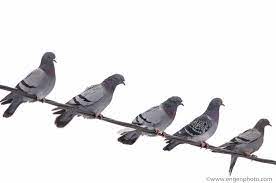
by Pigeon Patrol | Feb 16, 2022 | Bird Spike, Pigeon Droppings, Pigeon Patrol's Services, Pigeon Predators, Pigeon Spikes, Pigeons, Pigeons in the News
How to Get Rid of Pigeons from a Balcony
Getting rid of pigeons from small areas like balconies can be resolved with relatively simple common-sense solutions.
-
Wires. You can use a wire coil or stainless-steel wire to deter pigeons perching on rails.
-
Shock Track. Several suppliers offer a “shock track” system to keep birds off balconies. The shock track does not hurt the bird but provides enough stimulation to make the targeted perching area unattractive.
-
Netting. Consider using a netting system to physically exclude the birds from balconies. This is the costliest alternative, although if installed properly it’s 100% effective. Newer versions of netting are virtually invisible.
-
Sound or reflected light. The easiest way to deter pigeons from your patio, deck, or balcony, is with sound or reflected light. You can achieve this with a wind chime, Mylar balloon, aluminum foil pans or even hanging CD’s. The reflected light disorients the birds.
-
Plastic owl or rubber snake. Consider using scarecrows (“effigies”). The most common example is a plastic owl or rubber snake. Unfortunately, the effects will most likely be short-lived. The pigeons come to recognize the scarecrow as something that is not a threat.
-
Spikes. Consider using anti-perching spikes that you can attach anywhere the birds like to perch. Spikes are best advised for limited areas where the goal is to move the birds someplace else. They are available in different materials from plastic to stainless steel.
-
Gel Repellants. You can use gel repellants to ledges where pigeons perch. The gel makes the surface sticky and the birds will try to avoid it. Unfortunately, dust and debris take their toll and reapplication is often necessary. The application of gel repellants is not recommended where there are smaller birds. They can permanently get stuck in the goo

How to Get Rid of Pigeons from a Roof
Getting rid of pigeons from a residential or commercial roof can be far more challenging. Although some are better than others, all the solutions that apply for keeping pigeons off a balcony (above), can also apply to larger open areas.
-
Consider using a wire coil or stainless-steel wire to deter pigeons from perching on the ridge(s).
-
A “shock track” system might keep birds off rooftops
-
Using wire or netting is appropriate for a roof design that incorporates nooks. You can also apply nets where the pigeons can construct a nest.
-
Solar panels provide excellent harborage for pigeons. Metal grid netting is the most effective method to limit access to the birds.
-
Flat commercial roof styles have their own set of challenges. The first option is to electrify the parapet perching areas. The second option is to install simple spikes. Be aware that pigeons enjoy the comfort of HVAC installations. As a solution, consider netting these units.
How to Get Rid of Pigeons at Industrial Facilities
The basic nature and scope of modern industrial facilities make them highly attractive to pigeons. The design of these facilities is most often open which allows the birds ready ingress and egress. More importantly, pipes, beams, poles, and catwalks offer a wide range of harborage and nesting options. Food sources are typically located nearby and as mobile pests, pigeons can move around freely from one area of the plant to the next.
Pigeons can represent a costly nuisance for plants, and in many cases have been at the facility ever since it was built. Over time, the nests, feces, and debris can cause considerable damage to a plant’s mechanical and electrical components. Furthermore, the birds’ droppings and other debris add additional health hazards to an already hazardous area.
Most conventional methods of pigeon mitigation offer little comfort to an industrial facility and decision makers often select culling solutions since everything else is either prohibitively costly or impractical. Methods such as trapping and poisoning the birds may help alleviate the problem temporarily, however, due to their rapid breeding, pigeons always return and repopulate the very attractive site in a few weeks or months.
While highly effective at smaller sites, physical exclusion is typically not an option at a larger plant. It is simply impossible to cover an oil refinery or power plant with a net.
The more common solutions for smaller scale facilities are only appropriate for the resolution of isolated problems at a larger plant. An area where there is zero tolerance for birds mandates physical exclusion to keep them out, while the overall control strategy needs to focus on abatement.
The following graphic provides an outline of the various options for bird abatement. There are just two alternatives:
-
Increase mortality with the common culling methods, trap, shoot or poison
-
Reduce reproduction with a contraceptive.
The most effective method at a complex installation is a control program based on OvoControl. A contraceptive has exceptional utility in these large sites where conventional bird control methods may not be appropriate or cost effective.
While baiting birds without killing them may seem counterintuitive to some, the successful long-term use of OvoControl at a wide range of different industrial facilities demonstrates otherwise.
OvoControl provides a safe, easy-to-use, and effective solution for everything from oil refineries to power plants to control the pigeon population for good.
OvoControl reduces the population naturally, through attrition, over time. With continued use, the population declines at a rate of roughly 50%, annually. With a successful contraceptive program, industrial facilities will ultimately drive their pigeon population down by 90 to 95%.
Furthermore, many industrial facilities often have challenging sites for environmental stewardship. Thankfully, OvoControl represents an environmentally benign pigeon mitigation strategy which does not pose secondary risks to raptors or scavengers.
NO SINGLE METHOD OR SOLUTION WILL SOLVE ALL PIGEON PROBLEMS
Short of exterminating the birds, there is no foolproof way to get rid of all of them. Pigeons have accompanied mankind for thousands of years and, like rats, are not leaving anytime soon. Unfortunately, even the effects of lethal methods are only effective in the short-term as the remaining flock rapidly breeds back the ones that are missing. Lethal solutions often represent a “harvest” of pigeons as opposed to an actual control program. Both larger and smaller problems can be solved with the techniques outlined above although all but the simplest sites require some observation and planning to develop a safe and effective strategy for success.
WHY NOT JUST KILL THE BIRDS?
Irrespective of any humane considerations, the casual observer often asks, “why not just kill the birds” for a prompt and effective resolution to a pigeon problem? While culling options provide an immediate and tangible solution to an acute pigeon problem, the effects are fleeting. More often than not, the population will simply “backfill” the void created by culling with increased reproduction and even more birds. Unfortunately, just killing the birds just provides the illusion of control. Only by limiting reproduction can you effectively manage the population in a manner to provide long-term control. Over time, killing pigeons more closely resembles a harvest as opposed to an actual control program.
Source
Pigeon Patrol Products & Services is the leading manufacturer and distributor of bird deterrent (control) products in Canada. Pigeon Patrol products have solved pest bird problems in industrial, commercial, and residential settings since 2000, by using safe and humane bird deterrents with only bird and animal friendly solutions. At Pigeon Patrol, we manufacture and offer a variety of bird deterrents, ranging from Ultra-flex Bird Spikes with UV protection, Bird Netting, 4-S Bird Gel and the best Ultrasonic and audible sound devices on the market today.
Voted Best Canadian wholesaler for Bird Deterrent products ten years in a row.
Contact us at 1- 877– 4– NO-BIRD, (604) 585-9279 or visit our website at www.pigeonpatrol.ca
Pigeon/Pigeon Patrol / Pigeons Roosting / Vancouver Pigeon Control /Bird Spikes / Bird Control / Bird Deterrent / Pigeon Deterrent? Surrey Pigeon Control / Pest /Seagull deterrent / Vancouver Pigeon Blog / Birds Inside Home / Pigeons in the cities / Ice Pigeons/ What to do about pigeons/ sparrows , Damage by Sparrows, How To Keep Raccoons Away, Why Are Raccoons Considered Pests/ De-fence / Pigeon Nesting/ Bird Droppings / Pigeon Dropping/ woodpecker control/ Professional Bird Control Company/ Keep The Birds Away/ Birds/rats/ seagull/pigeon/woodpecker/ dove/sparrow/pidgeon control/pidgeon problem/ pidgeon control/flying rats/ pigeon Problems/ bird netting/bird gel/bird spray/bird nails/ bird guard

by Pigeon Patrol | Feb 16, 2022 | Bird Spike, Pigeon Spikes, Pigeons, Pigeons in the News, Raccoons, Sparrows
Be patient with a family of pigeons
If the babies have already hatched, really the only thing you can do is wait for them to grow up and fly away. Don’t worry — baby pigeons grow up very quickly! The time between when they hatch from the egg to when they fly away from their nest is usually less than 4 weeks. Once they leave, the babies don’t come back to the nest again.
The parents may try to start another nest in the same spot, even before the first babies have grown up and flown off. Read on to find out how to keep them from nesting on your balcony in the future.
Can’t I just move the nest?
No. Pigeons are very location-specific when it comes to their nest site. Moving the nest over even a few feet — say to a neighbouring balcony — can cause the parents to abandon the nest.
Baby pigeons NEED their parents — they cannot survive without them. Their parents feed them, keep them warm, and even after they’ve left the nest mom and dad show them how to fly, escape from predators, and integrate with the flock.
If you take the babies off of your balcony and move them, even if it’s to a “nice” spot like the local park, they will die. The best thing to do is to let the parents raise this one set of babies. It will take less than a month, they grow up so fast. Once the babies have flown away, you can prevent the pigeons from nesting again in the future.
Keep things tidy
Clean up or put away any things you might be storing on your balcony that are providing shelter or hiding spots for the pigeons to nest. Sweep away any feces or nesting material. It’s fine to do this cleaning while the babies are still on the balcony, just stay away from the exact spot the nest is in.
Remember, the parent pigeons may lay a new set of eggs before the first babies are grown up and gone. You will have to be diligent and go outside every day to sweep away any fresh nesting material. Eventually, the pigeons will get the message that your balcony is not a good place to nest, and they’ll go elsewhere.
What if they lay another set of eggs?
If they do lay a new set of eggs, provided you know that they were laid less than a week ago, it’s fine to dispose of them. We recommend taking them to the local park and hiding them under a bush – that way they can go back to being a part of nature.
If there is a new set of eggs and you’re not sure when they were laid, or you know they’re over two weeks old, we recommend leaving them be and letting the parents raise that brood. Pigeons usually incubate their eggs for about 3 weeks, and then the babies take about 4 weeks to grow up after hatching.

How to keep pigeons from nesting in the future
There are a few different things you can try to make your balcony less attractive to pigeons looking for a place to nest. Remember to wait until AFTER the babies have grown up and flown away before implementing any of these measures. You don’t want to separate the babies from their parents – they will die without their mom and dad.
Keep things tidy
Keeping things tidy and uncluttered is the first step. Pigeons like to choose a sheltered nest spot, so they like furniture and storage items to hide behind. Going out every day and sweeping off any new nesting material is the best thing you can do to prevent pigeon nests. Even just your presence out on the balcony will be enough to discourage many pigeons from nesting. We usually find that nests are made when no one is using the balcony, either early in the season or when the occupants have been out of town for a while.
Keep pigeons from perching
Adult pigeons like to perch on the railing of their nest-site balcony, so they can look around and spot any nearby predators. If you make it impossible to perch on the railing, they’ll usually find somewhere else to go.
We recommend a single length of wire or heavy gauge fishing line. Secure the line tautly about 2-3 inches above and parallel to the balcony railing. Tying it to nails or screws at either end can work. Pigeons aren’t technically perching birds, so it’s hard for them to stand on a piece of wire so thin. They won’t want to build their nest on a balcony where they can’t look out for predators.
Commercial flexible pigeon coils and wires can also work, but will be more expensive to install. We never recommend the use of sticky deterrents, because they can harm both pigeons and other species of birds.
Scare the pigeons away from the balcony
The best thing to scare pigeons away from a balcony is frequent human presence. We usually find that nests are made when no one is using the balcony, either early in the season or when the occupants have been out of town for a while.
You can also use visual deterrents to keep pigeons away from your balcony. Strips of shiny wrapping paper blowing in the breeze, old CDs hanging from string, and colourful spinning pinwheels are some cheap and easy options. Any visual deterrent will be more effective if you move it around or change it up regularly.
And no, those plastic owls don’t really work. At least not for pigeons.
Be careful with pigeon netting
Completely netting in a balcony or ledge can be a very effective way of keeping pigeons from nesting or roosting in that spot. However, pigeon netting MUST be professionally installed and regularly maintained! When pigeon netting gets loose and floppy, it becomes a danger to pigeons, hawks, sparrows, and any other birds that might fly into it and get tangled up.
It is also important to wait until any active nests are finished and all babies have flown away before installing pigeon netting. If the babies are separated from their parents, they will die.
Pigeon Patrol Products & Services is the leading manufacturer and distributor of bird deterrent (control) products in Canada. Pigeon Patrol products have solved pest bird problems in industrial, commercial, and residential settings since 2000, by using safe and humane bird deterrents with only bird and animal friendly solutions. At Pigeon Patrol, we manufacture and offer a variety of bird deterrents, ranging from Ultra-flex Bird Spikes with UV protection, Bird Netting, 4-S Bird Gel and the best Ultrasonic and audible sound devices on the market today.
Voted Best Canadian wholesaler for Bird Deterrent products ten years in a row.
Contact us at 1- 877– 4– NO-BIRD, (604) 585-9279 or visit our website at www.pigeonpatrol.ca
Pigeon/Pigeon Patrol / Pigeons Roosting / Vancouver Pigeon Control /Bird Spikes / Bird Control / Bird Deterrent / Pigeon Deterrent? Surrey Pigeon Control / Pest /Seagull deterrent / Vancouver Pigeon Blog / Birds Inside Home / Pigeons in the cities / Ice Pigeons/ What to do about pigeons/ sparrows , Damage by Sparrows, How To Keep Raccoons Away, Why Are Raccoons Considered Pests/ De-fence / Pigeon Nesting/ Bird Droppings / Pigeon Dropping/ woodpecker control/ Professional Bird Control Company/ Keep The Birds Away/ Birds/rats/ seagull/pigeon/woodpecker/ dove/sparrow/pidgeon control/pidgeon problem/ pidgeon control/flying rats/ pigeon Problems/ bird netting/bird gel/bird spray/bird nails/ bird guard
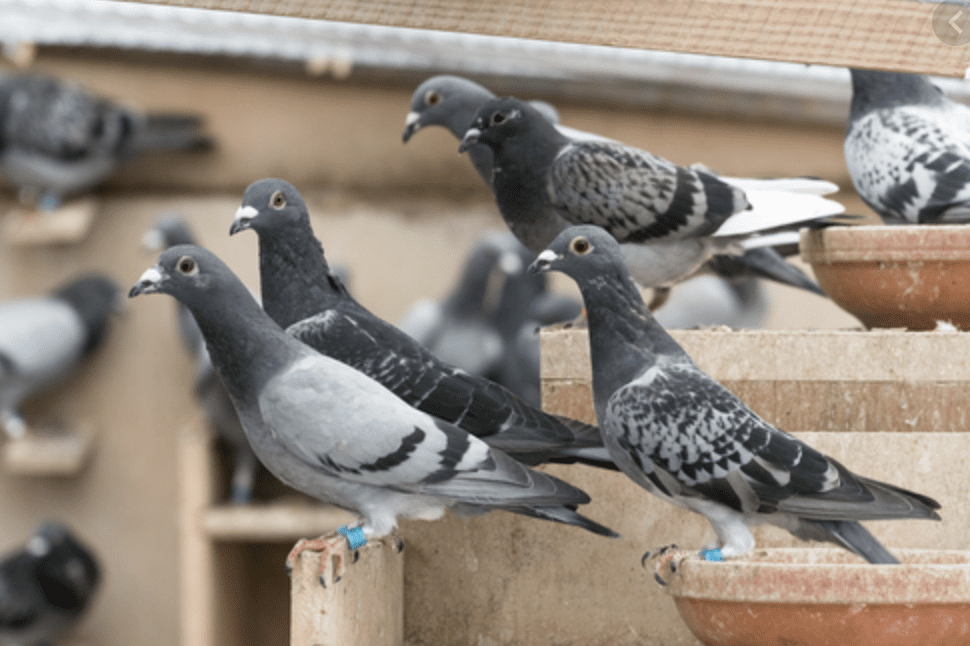
by Pigeon Patrol | Feb 7, 2022 | Pigeon Predators, Pigeon Spikes, Pigeons, Pigeons in the News, Raccoons, Sparrows, UltraSonic Bird Control
A local wildlife organization is concerned about the number of sick pigeons it’s finding in Regina’s downtown.
Megan Lawrence, director of rehabilitation for Salthaven West, said her organization is frequently called for reports of pigeons in distress.
She said Salthaven has been dealing with the birds for years now and fears they might have been poisoned.
“On average we’re seeing a poisoned pigeon every two to three weeks,” she said, adding those numbers increase in the summer. “It’s not a very humane death. Their temperature skyrockets; it can be a very painful death.”
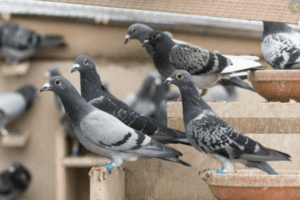
“By the time we receive them, they’re having violent seizures,” she said. “The only thing we can do to get rid of the poison in their system is basically flush it out.”
Lawrence said she’s heard that some businesses downtown may be using poison in order to detract the birds from congregating on rooftops and other roosting points on buildings. However, she wasn’t able to offer any proof for her claims or pinpoint specific businesses and said she hasn’t spoken to any business owners herself.
The Leader-Post contacted some downtown businesses to see how they control the pigeon population. None of the businesses who responded said they use poison or have had an issue with pigeon overpopulation.
Kevin Lang, building manager for the Ramada Plaza located on Victoria Avenue, said while he has inquired with pest control companies about using poison to stop pigeons from roosting on the hotel’s roof, he’s never used it.
“I’ve been told … it affects the other (types of) birds,” he said. “(If) you put poison out, it can be consumed by anything that lands on our roof, which is not environmentally friendly.”
Instead, the hotel uses cages to keep them out. He said without them, pigeons can get into ventilation equipment and leave feathers in the rooftop coils.
Lawrence said if pigeons ingest poison, they aren’t the only ones who suffer. Animals who eat pigeons could be affected.
“If a Peregrine falcon was to eat one of those pigeons that had ingested the poison, the falcon is also going to get the poison and perhaps die as well,” she said.
Half of the pigeons they receive, she said, end up dying.
Salthaven’s most recent call to assist a pigeon was Wednesday evening. That one ended up dying. The organization doesn’t usually have pigeons tested to see what specific poison is making them sick, but it’s considering sending that one in for testing.
Lawrence believes the pigeons may be ingesting Avitrol, a bird control product she said is used in cities across Canada.
“It’s very common … to control pigeon populations this way,” she said. “It’s likely (because) it’s cheap and easy.”
In an email, the City of Regina said it doesn’t have a pigeon control program and doesn’t monitor pigeon populations.
On its website, the makers of Avitrol say the product “causes behaviours similar to an epileptic seizure.”
“Birds eating the treated bait will emit distress signals used by their species when they are frightened or injured,” the website says. “This will frighten the flock and cause it to leave the site.”
Several Regina pest control companies contacted by the Leader-Post said they do offer Avitrol, but it can only be administered in commercial and industrial areas and isn’t for retail sale. A trained pest control employee must administer it.
Instead of poison, Lawrence recommends removing structures where pigeons could roost and screen off air conditioning units where they might drink water from. Bristling wires, which prevent pigeons from landing, can also be purchased from a pest control retailer and installed.
“If they’re up on the roof and you start seeing them build nest, remove all nesting materials,” she said. “The more times that happens they’re going to realize this isn’t a place (they can) nest.”
Source
Pigeon Patrol Products & Services is the leading manufacturer and distributor of bird deterrent (control) products in Canada. Pigeon Patrol products have solved pest bird problems in industrial, commercial, and residential settings since 2000, by using safe and humane bird deterrents with only bird and animal friendly solutions. At Pigeon Patrol, we manufacture and offer a variety of bird deterrents, ranging from Ultra-flex Bird Spikes with UV protection, Bird Netting, 4-S Bird Gel and the best Ultrasonic and audible sound devices on the market today.
Voted Best Canadian wholesaler for Bird Deterrent products ten years in a row.
Contact us at 1- 877– 4– NO-BIRD, (604) 585-9279 or visit our website at www.pigeonpatrol.ca
Pigeon/Pigeon Patrol / Pigeons Roosting / Vancouver Pigeon Control /Bird Spikes / Bird Control / Bird Deterrent / Pigeon Deterrent? Surrey Pigeon Control / Pest /Seagull deterrent / Vancouver Pigeon Blog / Birds Inside Home / Pigeons in the cities / Ice Pigeons/ What to do about pigeons/ sparrows , Damage by Sparrows, How To Keep Raccoons Away, Why Are Raccoons Considered Pests/ De-fence / Pigeon Nesting/ Bird Droppings / Pigeon Dropping/ woodpecker control/ Professional Bird Control Company/ Keep The Birds Away/ Birds/rats/ seagull/pigeon/woodpecker/ dove/sparrow/pidgeon control/pidgeon problem/ pidgeon control/flying rats/ pigeon Problems/ bird netting/bird gel/bird spray/bird nails/ bird guard
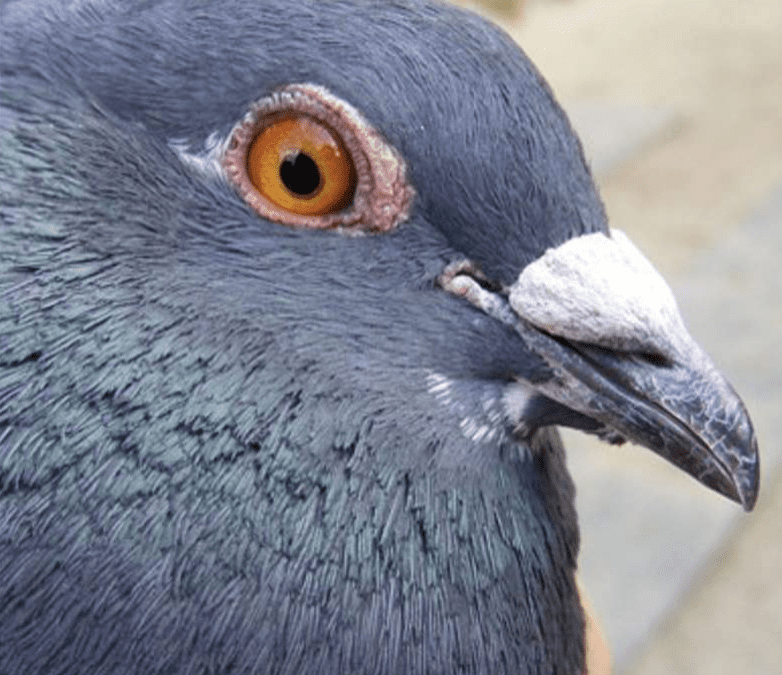
by Pigeon Patrol | Feb 7, 2022 | Bird Spike, Pigeon Predators, Pigeon Spikes, Pigeons, Pigeons in the News, Raccoons, Sparrows
Where do you go for your daily headlines? Your stock prices? Certainly not your neighborhood pigeons. Thomson Reuters, also known as The Answer Company, is the world’s largest provider of news and information to businesses and professionals. As early as the 1850s, they were sending news of bond prices across the English Channel on carrier pigeons.
Thomson Reuters, also known as The Answer Company, is the world’s largest provider of news and information to businesses and professionals. As early as the 1850s, they were sending news of bond prices across the English Channel on carrier pigeons.
Lincoln’s assassination was first reported into Europe by Baron Reuter, and he did it by sending fishing ships out to catch the steamers as they were coming across the Atlantic and getting back first. So being first, and being fast is paramount to Thomson Reuters, and it has been since day one.
Though much has changed and evolved since the days of its first office in the city of London where they transmitted share price quotes to Paris via the new Dover-Calais telegraph cable, what hasn’t changed is the responsibility to supply mission-critical news to businesses around the world.
With the rapid rise in digital advancements, what has changed, is the vast amount of information to manage. Professionals are consuming the news via mobile apps on various devices, portfolio management is influenced by headlines, and machines can be programmed to perform trades based upon market fluctuations. Getting it first is vitally important in the news business. Thomson Reuters leans on speed to meet the needs of today’s digital customers. Rapidity and accuracy is a duty its customers count upon them to fulfill; a duty they take seriously.
News Travels Fast
Using SAP HANA, they’ve been able to double the speed at which they can ingest polling data and get more than a tenfold increase in the way they analyze that data. Running live on SAP allows them to do what used to take days, and do it almost instantaneously.
A good example of this is the Polling Explorer. As you can imagine, the use of the polling explorer was widespread during the 2016 pre-elections. Today, Thomson Reuters’ polling data is easily interrogated. Back in the early eighties however, polling data meant a big book of data that landed on your desk with a thud, and this would be only the highlight results. If you really wanted to analyze that data, you would have to ask for cross-tabs to be created. It would take hours, if not days, to analyze what-ifs. With today’s level of data interactivity, running SAP HANA means getting a live data experience.
Source
Pigeon Patrol Products & Services is the leading manufacturer and distributor of bird deterrent (control) products in Canada. Pigeon Patrol products have solved pest bird problems in industrial, commercial, and residential settings since 2000, by using safe and humane bird deterrents with only bird and animal friendly solutions. At Pigeon Patrol, we manufacture and offer a variety of bird deterrents, ranging from Ultra-flex Bird Spikes with UV protection, Bird Netting, 4-S Bird Gel and the best Ultrasonic and audible sound devices on the market today.
Voted Best Canadian wholesaler for Bird Deterrent products ten years in a row.
Contact us at 1- 877– 4– NO-BIRD, (604) 585-9279 or visit our website at www.pigeonpatrol.ca
Pigeon/Pigeon Patrol / Pigeons Roosting / Vancouver Pigeon Control /Bird Spikes / Bird Control / Bird Deterrent / Pigeon Deterrent? Surrey Pigeon Control / Pest /Seagull deterrent / Vancouver Pigeon Blog / Birds Inside Home / Pigeons in the cities / Ice Pigeons/ What to do about pigeons/ sparrows , Damage by Sparrows, How To Keep Raccoons Away, Why Are Raccoons Considered Pests/ De-fence / Pigeon Nesting/ Bird Droppings / Pigeon Dropping/ woodpecker control/ Professional Bird Control Company/ Keep The Birds Away/ Birds/rats/ seagull/pigeon/woodpecker/ dove/sparrow/pidgeon control/pidgeon problem/ pidgeon control/flying rats/ pigeon Problems/ bird netting/bird gel/bird spray/bird nails/ bird guard
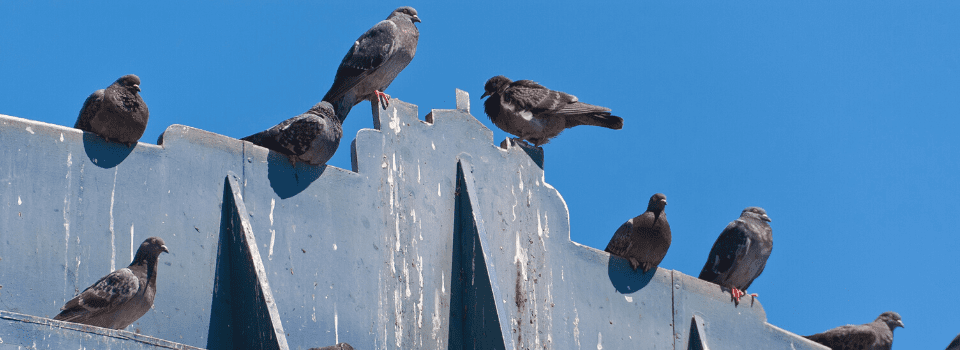
by Pigeon Patrol | Feb 7, 2022 | MBCA, pet bird, Pigeon Control, Pigeon Droppings, Pigeon Patrol's Services, Pigeon Predators
Contractors tackling the long-running pigeon problem at the Scottish Parliament have issued a warning about the potential health risks of bird muck on the building
This is not a recent problem. It was obvious from occasional visits years ago.
Maybe if it had been a more conventional design, this bizarre occurrence wouldn’t be happening.
Keep those windows open to ventilate for covid but never mind what untold diseases you might catch from pigeons.
Aberdeen train station has a weird electronic bird of prey which seems to keep pigeons away. The recording of the screeching sound is quite convincing and the silhouette is quite good too. The mechanical wing movement, not so much.
Would imagine they won’t be long in throwing resources at it unlike the damp and infestation in the housing that they turn a blind eye to.
Pigeons have done more for the people of the UK than that place. Flatten it, sack them and plant some trees.
Well that may be the excuse the other parties needed to say the SNP is suffering from mad doo disease!
Has anyone considered what the poor pigeons might catch from those that are already in that place.
Pigeons are more astute than I gave them credit for!
Is this not an issue at the new infirmary building too?
Chuck a loaf or two of bread on the building a day, keep them well fed.

I work in a pharmacy and we (so far) have had supplies coming in daily. We were only without any for a couple of hours and that’s only because people were constantly coming in for them, don’t panic there will be enough.
They were handing them out in Dobbies the other day; don’t know if they do this every day.
Costco were giving them out today.
Testing should only be done when someone feels unwell.
I made a fortune from my mates, isolation over in time for the New Year.
You can get them at testing center’s – got one today.
Yes, always managed to get them online or at the local chemist.
Shambles! Cheese and wine more important!
Yes, I was given some last week when I had my booster.
No, can’t find any. I’m asthmatic and have COPD – it scares me that I can’t find any.
Handing them out in Midlothian Community Hospital.
Yes, got some yesterday at Ainslie Park Leisure Centre.
Piershill has become a battleground of wills between residents and the council over how bins should be serviced
Edinburgh council should give themselves a round of applause. Well done in transforming one of the most beautiful cities in the world into a third world slum.
Source
Pigeon Patrol Products & Services is the leading manufacturer and distributor of bird deterrent (control) products in Canada. Pigeon Patrol products have solved pest bird problems in industrial, commercial, and residential settings since 2000, by using safe and humane bird deterrents with only bird and animal friendly solutions. At Pigeon Patrol, we manufacture and offer a variety of bird deterrents, ranging from Ultra-flex Bird Spikes with UV protection, Bird Netting, 4-S Bird Gel and the best Ultrasonic and audible sound devices on the market today.
Voted Best Canadian wholesaler for Bird Deterrent products ten years in a row.
Contact us at 1- 877– 4– NO-BIRD, (604) 585-9279 or visit our website at www.pigeonpatrol.ca
Pigeon/Pigeon Patrol / Pigeons Roosting / Vancouver Pigeon Control /Bird Spikes / Bird Control / Bird Deterrent / Pigeon Deterrent? Surrey Pigeon Control / Pest /Seagull deterrent / Vancouver Pigeon Blog / Birds Inside Home / Pigeons in the cities / Ice Pigeons/ What to do about pigeons/ sparrows , Damage by Sparrows, How To Keep Raccoons Away, Why Are Raccoons Considered Pests/ De-fence / Pigeon Nesting/ Bird Droppings / Pigeon Dropping/ woodpecker control/ Professional Bird Control Company/ Keep The Birds Away/ Birds/rats/ seagull/pigeon/woodpecker/ dove/sparrow/pidgeon control/pidgeon problem/ pidgeon control/flying rats/ pigeon Problems/ bird netting/bird gel/bird spray/bird nails/ bird guard
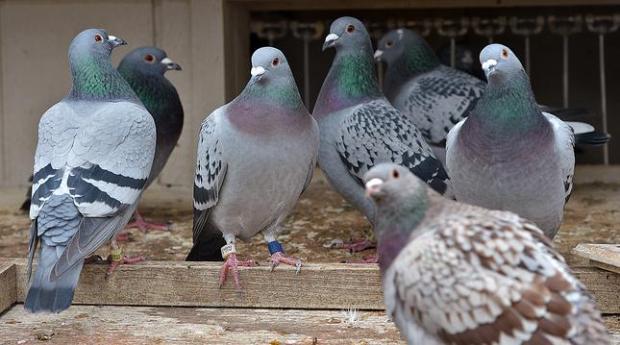
by Pigeon Patrol | Feb 7, 2022 | 4-S Gel Bird repellent, Animal Deterrent Products, Bird Deterrent Products, Bird Law, Bird Netting, Bird Spikes
Mattawa’s pigeon feeders have been warned—the free lunches stop now.
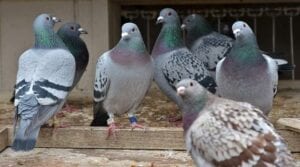
Council recently approved a bylaw prohibiting the feeding of pigeons, a ban that encompasses the entire municipality.
Cracked corn, seeds, cereal grains, wheat, and barley make delectable dishes for pigeons, and many people enjoy indulging this aviary desire to while away some time, or to make the birds’ lives a little easier.
But for Mattawa residents the practice is no longer accepted. And those who continue distributing the seed may be fined $250.
See: Pigeon poop proves a problem. Police involved
Moreover, if one attracts pigeons, and this flock results in a public nuisance, another fine of $250 can be issued. This is separate from the feeding fine. Think twice before installing that pigeon motel in your garden.
The bylaw came about after the municipality received numerous complaints regarding the birds over the past year.
“Pigeons are destroying rooftops, property, and our beautiful downtown area with their feces,” explained Councillor Loren Mick, in his report to council.
“The biggest problem” he noted is also the most preventable: “people feeding them.”
Hence the bylaw to remove “unwanted pigeon pests,” which will “promote the use and enjoyment of property in a healthy and sanitary manner.”
Source
Pigeon Patrol Products & Services is the leading manufacturer and distributor of bird deterrent (control) products in Canada. Pigeon Patrol products have solved pest bird problems in industrial, commercial, and residential settings since 2000, by using safe and humane bird deterrents with only bird and animal friendly solutions. At Pigeon Patrol, we manufacture and offer a variety of bird deterrents, ranging from Ultra-flex Bird Spikes with UV protection, Bird Netting, 4-S Bird Gel and the best Ultrasonic and audible sound devices on the market today.
Voted Best Canadian wholesaler for Bird Deterrent products ten years in a row.
Contact us at 1- 877– 4– NO-BIRD, (604) 585-9279 or visit our website at www.pigeonpatrol.ca
Pigeon/Pigeon Patrol / Pigeons Roosting / Vancouver Pigeon Control /Bird Spikes / Bird Control / Bird Deterrent / Pigeon Deterrent? Surrey Pigeon Control / Pest /Seagull deterrent / Vancouver Pigeon Blog / Birds Inside Home / Pigeons in the cities / Ice Pigeons/ What to do about pigeons/ sparrows , Damage by Sparrows, How To Keep Raccoons Away, Why Are Raccoons Considered Pests/ De-fence / Pigeon Nesting/ Bird Droppings / Pigeon Dropping/ woodpecker control/ Professional Bird Control Company/ Keep The Birds Away/ Birds/rats/ seagull/pigeon/woodpecker/ dove/sparrow/pidgeon control/pidgeon problem/ pidgeon control/flying rats/ pigeon Problems/ bird netting/bird gel/bird spray/bird nails/ bird guard
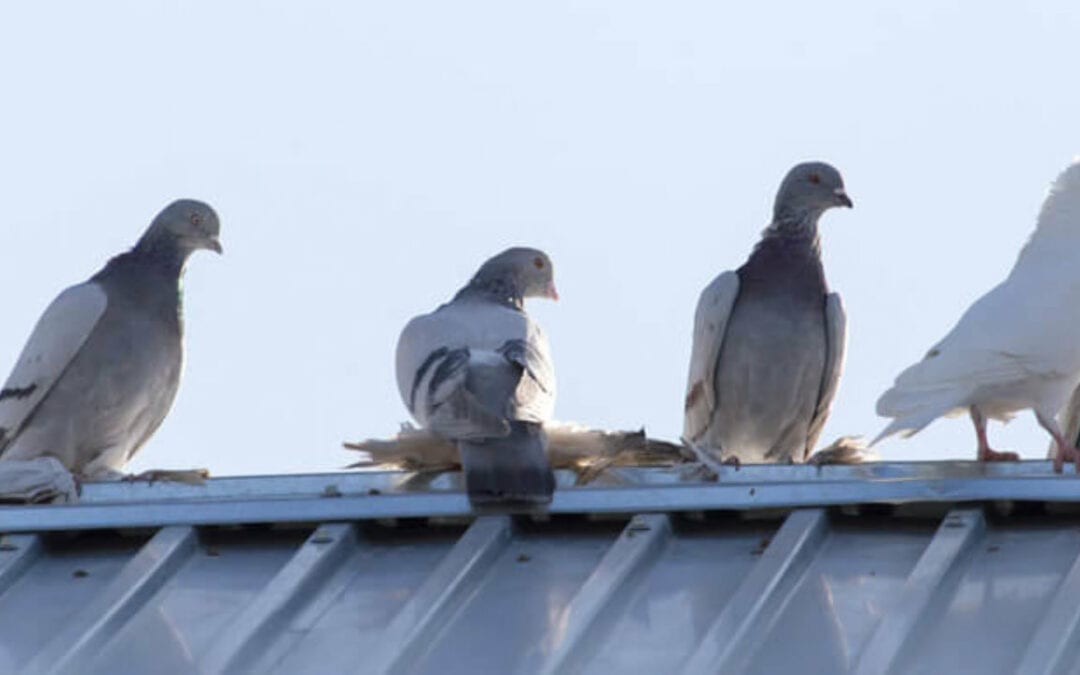
by Pigeon Patrol | Feb 7, 2022 | Pigeon Spikes, Pigeons, Pigeons in the News, Raccoons, Sparrows, UltraSonic Bird Control
A Toronto resident recorded a video of a man snatching pigeons in the city’s east end and when she tried to report it to officials, she said no one wanted to investigate.
On Sunday morning, Bruna Doberstein was on her way home when she witnessed a man and a child capturing the birds with a net and placing them inside a crowded cage in a parking lot at Lawrence Avenue East and Markham Road. That’s when she decided to take out her phone and start recording.
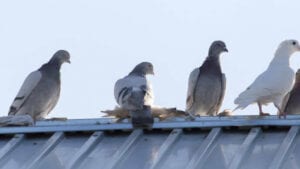
“I expected he would stop doing it after he saw that I was recording. But he didn’t. He seemed pretty comfortable doing it,” Doberstein told CityNews.
In the video, you can hear Doberstein asking the man why he was trapping the pigeons and that he “can’t do this,” in which he responds “Yes I can. I take them to my farm and I raise them.”
Doberstein said she didn’t buy it.
“He wasn’t being gentle. He was holding the birds by their wings. A person who would raise the birds would be at least careful and keep them safe” she said. “I don’t know the story but I know it’s not good.”
At that moment, Doberstein decided to call the police. She said that while the officer was courteous, she was told that it wasn’t their jurisdiction and they wouldn’t be sending an officer.
Instead they told her to call 311. But she said from past experience, Doberstein didn’t think they would be of any help in this matter.
This wasn’t the first time she witnessed the man capturing a cage full of birds and it also wasn’t the first time she tried reporting on what she witnessed.
“It was the second time I saw this guy. I recognized the truck from almost a year ago in August in the same parking lot.”
She told CityNews that last year she contacted a variety of different municipal and provincial departments with no luck, “I called PAWS (Provincial Animal Welfares services) and The Ministry of Nature and Forestry too and I never heard back.”
This kind of response isn’t unusual, according to Camille Labchuck, animal rights lawyer and executive director of Animal Justice.
“In my experience this is not uncommon when it comes to animal issues and law enforcement agencies,” said Labchuck. “Because a lot of people have authority also means that nobody does, leading to nobody wanting to pick it up and run with it.”
While Labchuck and her team are disappointed that Toronto Animal Services and police didn’t do more, they ultimately had more success with reporting the incident to Provincial Animal Welfare Services and the Ministry of Natural Resources and Forestry.
“PAWS is the agency that took over enforcement from the OSPCA two years back. They are tasked with investigating any animal cruelty problems.” Labchuck explained. Something many people may not be aware of.
Since the OSPCA announced in 2019 it will no longer enforce animal cruelty laws, there has been no clear guidance of who one should contact to report, investigate and enforce animal cruelty laws.
“You got a man roughly handling birds by the wings which is not permitted,” Labchuck said. “To say nothing of the fact that he shouldn’t be interacting with pigeons anyways. They are protected species under the federal Migratory Bird Convention Act”.
The Ministry of Natural Resources and Forestry are in charge of enforcing the wildlife act. Labchuck said there could be a clear violation here as residents can’t interact with native wildlife without a permit.
However, while both departments took down information, neither would accept the video at this stage.
“They both advised that providing the video would be a next step if an enforcement officer requires it. Kind of bizarre as it’s relevant evidence at the outset,” Labchuck said.
In 2015, the illegal trapping of pigeons became a widespread issue in the city of New York after hundreds were believed to be stolen for live pigeon shoots in neighbouring states.
Source
Pigeon Patrol Products & Services is the leading manufacturer and distributor of bird deterrent (control) products in Canada. Pigeon Patrol products have solved pest bird problems in industrial, commercial, and residential settings since 2000, by using safe and humane bird deterrents with only bird and animal friendly solutions. At Pigeon Patrol, we manufacture and offer a variety of bird deterrents, ranging from Ultra-flex Bird Spikes with UV protection, Bird Netting, 4-S Bird Gel and the best Ultrasonic and audible sound devices on the market today.
Voted Best Canadian wholesaler for Bird Deterrent products ten years in a row.
Contact us at 1- 877– 4– NO-BIRD, (604) 585-9279 or visit our website at www.pigeonpatrol.ca
Pigeon/Pigeon Patrol / Pigeons Roosting / Vancouver Pigeon Control /Bird Spikes / Bird Control / Bird Deterrent / Pigeon Deterrent? Surrey Pigeon Control / Pest /Seagull deterrent / Vancouver Pigeon Blog / Birds Inside Home / Pigeons in the cities / Ice Pigeons/ What to do about pigeons/ sparrows , Damage by Sparrows, How To Keep Raccoons Away, Why Are Raccoons Considered Pests/ De-fence / Pigeon Nesting/ Bird Droppings / Pigeon Dropping/ woodpecker control/ Professional Bird Control Company/ Keep The Birds Away/ Birds/rats/ seagull/pigeon/woodpecker/ dove/sparrow/pidgeon control/pidgeon problem/ pidgeon control/flying rats/ pigeon Problems/ bird netting/bird gel/bird spray/bird nails/ bird guard

by Pigeon Patrol | Feb 2, 2022 | MBCA, pet bird, Pigeon Control, Pigeon Droppings, Pigeon Patrol's Services, Pigeon Predators
Feeding birds is a wonderful way to help your yard’s avian visitors fuel up for migration and make it through a tough winter. It can also provide great opportunities for wildlife photography and observation. But it’s not enough to set your feeder and forget it. You need to clean it out, or you risk inadvertently causing the birds that visit to get sick. The same goes for birdbaths.
Some of the more common diseases that birds can spread through feeders include house finch eye disease (the colloquial name for mycoplasmal conjunctivitis, which can infect more than just the bird for which it’s named), salmonellosis (caused by salmonella bacteria), aspergillosis (a fungal respiratory disease), and avian pox. If you see a sick bird or one you suspect died from a disease outbreak, don’t pick it up or try to treat it yourself. Instead, follow these tips from the Cornell Lab of Ornithology, or call the National Wildlife Health Center for instructions.
To prevent the spread of illness in the birds that frequent your seed buffet, try these three steps:
Clean feeders regularly
The National Wildlife Health Center recommends cleaning bird baths and feeders with a solution of nine parts water to one part bleach. (If there is visible debris, scrub it off before soaking in the bleach solution.) Dry out the feeder before hanging it back up. Project FeederWatch, a joint effort between Cornell Lab of Ornithology and Birds Canada, recommends cleaning seed feeders every two weeks or so. Double the frequency of cleaning if you suspect disease a-lurking.
Tidy below the feeder
This can mean raking or shoveling up feces and hulls (seed casings)—particularly those that are moldy, wet, or spoiled—and throwing them out, Project Feederwatch recommends. That’ll also help prevent scattered food from attracting rodents. On snow-covered lawns, scraping off a few layers of snow should do the trick.
Pigeon Patrol Products & Services is the leading manufacturer and distributor of bird deterrent (control) products in Canada. Pigeon Patrol products have solved pest bird problems in industrial, commercial, and residential settings since 2000, by using safe and humane bird deterrents with only bird and animal friendly solutions. At Pigeon Patrol, we manufacture and offer a variety of bird deterrents, ranging from Ultra-flex Bird Spikes with UV protection, Bird Netting, 4-S Bird Gel and the best Ultrasonic and audible sound devices on the market today.
Voted Best Canadian wholesaler for Bird Deterrent products ten years in a row.
Contact us at 1- 877– 4– NO-BIRD, (604) 585-9279 or visit our website at www.pigeonpatrol.ca
Pigeon/Pigeon Patrol / Pigeons Roosting / Vancouver Pigeon Control /Bird Spikes / Bird Control / Bird Deterrent / Pigeon Deterrent? Surrey Pigeon Control / Pest /Seagull deterrent / Vancouver Pigeon Blog / Birds Inside Home / Pigeons in the cities / Ice Pigeons/ What to do about pigeons/ sparrows , Damage by Sparrows, How To Keep Raccoons Away, Why Are Raccoons Considered Pests/ De-fence / Pigeon Nesting/ Bird Droppings / Pigeon Dropping/ woodpecker control/ Professional Bird Control Company/ Keep The Birds Away/ Birds/rats/ seagull/pigeon/woodpecker/ dove/sparrow/pidgeon control/pidgeon problem/ pidgeon control/flying rats/ pigeon Problems/ bird netting/bird gel/bird spray/bird nails/ bird guard
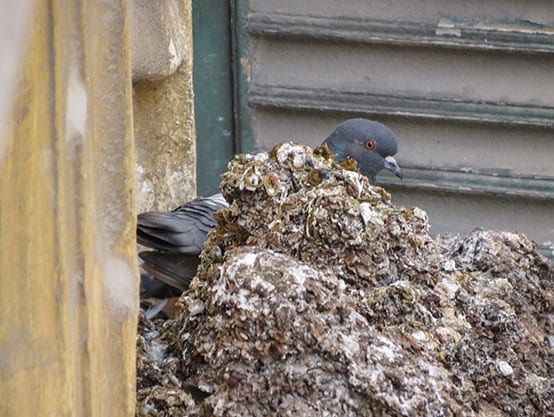
by Pigeon Patrol | Feb 2, 2022 | MBCA, pet bird, Pigeon Control, Pigeon Droppings, Pigeon Patrol's Services, Pigeon Predators
Enteric illnesses remain the second largest source of communicable diseases worldwide, and wild birds are suspected sources for human infection. This has led to efforts to reduce pathogen spillover through deterrence of wildlife and removal of wildlife habitat, particularly within farming systems, which can compromise conservation efforts and the ecosystem services wild birds provide. Further, Salmonella spp. are a significant cause of avian mortality, leading to additional conservation concerns. Despite numerous studies of enteric bacteria in wild birds and policies to discourage birds from food systems, we lack a comprehensive understanding of wild bird involvement in transmission of enteric bacteria to humans. Here, we propose a framework for understanding spillover of enteric pathogens from wild birds to humans, which includes pathogen acquisition, reservoir competence and bacterial shedding, contact with people and food, and pathogen survival in the environment. We place the literature into this framework to identify important knowledge gaps. Second, we conduct a meta-analysis of prevalence data for three human enteric pathogens, Campylobacter spp., E. coli, and Salmonella spp., in 431 North American breeding bird species. Our literature review revealed that only 3% of studies addressed the complete system of pathogen transmission. In our meta-analysis, we found a Campylobacter spp. prevalence of 27% across wild birds, while prevalence estimates of pathogenic E. coli (20%) and Salmonella spp. (6.4%) were lower. There was significant bias in which bird species have been tested, with most studies focusing on a small number of taxa that are common near people (e.g. European starlings Sturnus vulgaris and rock pigeons Columba livia) or commonly in contact with human waste (e.g. gulls). No pathogen prevalence data were available for 65% of North American breeding bird species, including many commonly in contact with humans (e.g. black-billed magpie Pica hudsonia and great blue heron Ardea herodias), and our metadata suggest that some under-studied species, taxonomic groups, and guilds may represent equivalent or greater risk to human infection than heavily studied species. We conclude that current data do not provide sufficient information to determine the likelihood of enteric pathogen spillover from wild birds to humans and thus preclude management solutions. The primary focus in the literature on pathogen prevalence likely overestimates the probability of enteric pathogen spillover from wild birds to humans because a pathogen must survive long enough at an infectious dose and be a strain that is able to colonize humans to cause infection. We propose that future research should focus on the large number of under-studied species commonly in contact with people and food production and demonstrate shedding of bacterial strains pathogenic to humans into the environment where people may contact them. Finally, studies assessing the duration and intensity of bacterial shedding and survival of bacteria in the environment in bird faeces will help provide crucial missing information necessary to calculate spillover probability. Addressing these essential knowledge gaps will support policy to reduce enteric pathogen spillover to humans and enhance bird conservation efforts that are currently undermined by unsupported fears of pathogen spillover from wild birds.

a pigeon bird standing by guano manure
Source
Pigeon Patrol Products & Services is the leading manufacturer and distributor of bird deterrent (control) products in Canada. Pigeon Patrol products have solved pest bird problems in industrial, commercial, and residential settings since 2000, by using safe and humane bird deterrents with only bird and animal friendly solutions. At Pigeon Patrol, we manufacture and offer a variety of bird deterrents, ranging from Ultra-flex Bird Spikes with UV protection, Bird Netting, 4-S Bird Gel and the best Ultrasonic and audible sound devices on the market today.
Voted Best Canadian wholesaler for Bird Deterrent products ten years in a row.
Contact us at 1- 877– 4– NO-BIRD, (604) 585-9279 or visit our website at www.pigeonpatrol.ca
Pigeon/Pigeon Patrol / Pigeons Roosting / Vancouver Pigeon Control /Bird Spikes / Bird Control / Bird Deterrent / Pigeon Deterrent? Surrey Pigeon Control / Pest /Seagull deterrent / Vancouver Pigeon Blog / Birds Inside Home / Pigeons in the cities / Ice Pigeons/ What to do about pigeons/ sparrows , Damage by Sparrows, How To Keep Raccoons Away, Why Are Raccoons Considered Pests/ De-fence / Pigeon Nesting/ Bird Droppings / Pigeon Dropping/ woodpecker control/ Professional Bird Control Company/ Keep The Birds Away/ Birds/rats/ seagull/pigeon/woodpecker/ dove/sparrow/pidgeon control/pidgeon problem/ pidgeon control/flying rats/ pigeon Problems/ bird netting/bird gel/bird spray/bird nails/ bird guard
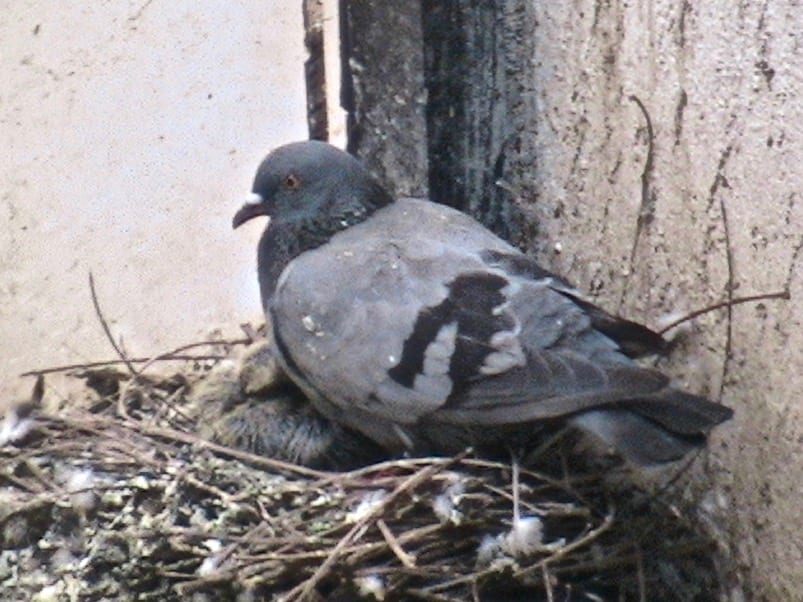
by Pigeon Patrol | Feb 2, 2022 | MBCA, pet bird, Pigeon Control, Pigeon Droppings, Pigeon Patrol's Services, Pigeon Predators
Work with bird or bat droppings can expose workers to some serious, infectious diseases.
Bird and bat droppings
The risk from disturbing small amounts of fresh droppings is very low but grows higher from disturbing large accumulations of concentrated, dried droppings.
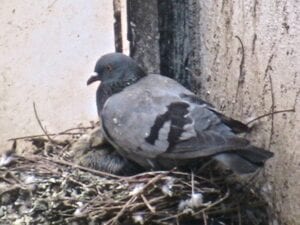
Histoplasmosis
Histoplasmosis is an infection caused by a fungus called Histoplasma capsulatum. It is found in soil contaminated with bird (especially pigeon) or bat droppings. People can be infected by inhaling the fungal spores. Young children, the elderly and people who have a medical condition or are undergoing medical treatment that lowers immunity are most at risk.
Cryptococcosis
Cryptococcosis is an infection caused by a fungus called Cryptococcosis neoformans. It is found in the environment, particularly in soil that is contaminated with bird (especially pigeon) droppings. People can be infected by inhaling the fungal spores. Infection is rare in people who are otherwise healthy but those with low immunity are at increased risk. Cryptococcosis commonly causes meningitis (an infection of the brain) but infection can occur in other parts of the body.
Psittacosis
Psittacosis is caused by bacteria called Chlamydia [or Chlamydophilia] psittaci. It is shed in the droppings and respiratory secretions of infected birds, including parrots, pigeons and poultry. People can be infected by inhaling the bacteria. Psittacosis generally causes a mild to moderate respiratory illness with pneumonia, but more severe illness can occur. Young children, the elderly, pregnant women and people who have a medical condition or are undergoing medical treatment that lowers immunity are most at risk.
Gastrointestinal illness
Bird and bat droppings can contain germs that cause gastrointestinal illness with symptoms of nausea, vomiting and diarrhoea. People can be infected if they inadvertently swallow the germs, usually via contaminated hands.
Who is at risk?
Workers who disturb accumulations of dried bird or bat droppings are at risk. For example:
- workers who clean, renovate or demolish buildings, roofs, bridges and other structures where birds or bats roost
- spelunkers (cave explorers) and others who work in caves or other enclosed spaces harbouring birds or bats
- pest control and animal removal specialists
- facilities maintenance workers
- heating, ventilation and air conditioning (HVAC) systems workers
- workers who handle poultry manure
- workers who work with soil or clear foliage in areas harbouring birds or bats.
Managing exposure
Eliminating exposure is the most effective way to protect workers, however this may not always be possible. Where the risk cannot be eliminated, it must be minimised.
Prevent droppings from accumulating
- Deter birds by sealing entry points, modifying roosting or nesting sites and removing food sources. Seek advice from an animal removal or pest control specialist if required.
- Regularly inspect for droppings and clean up promptly.
Cleaning large accumulations of bird and bat droppings
- Where possible, schedule cleaning activities for when the site is not being used and restrict access. Take special care if vulnerable people such as patients, elderly residents or young children could be in the affected area.
- Manage exposure to dust and aerosols from disturbing droppings. For example
- use dust barriers and ventilation controls (e.g. industrial vacuum (PDF, 0.62 MB), HEPA filtration unit)
- seal doors, windows and air vents
- avoid cleaning methods that disperse dust and aerosols (e.g. dry sweeping, high-pressure washer, household vacuum and compressed air)
- wet the droppings by applying a light mist of plain or soapy water and keep wetting the material during its removal to prevent it from drying out.
- Once the droppings are removed, clean the area thoroughly using water and detergent and then apply a disinfectant. Disinfectants require a minimum contact time to be effective. They may not work properly in the presence of organic matter such as droppings, so it is important to clean surfaces before applying disinfectant. Alternatively, use a product that is both a detergent and a disinfectant.
- Place waste in a container that can be securely sealed during storage, transport and disposal.
- Clean contaminated equipment and tools after use.
- Do not reuse contaminated building materials and debris.
- It is unnecessary to test surfaces before or after cleaning because the types of germs found in droppings are widespread in the environment.
- Consider using a professional cleaning service that specializes in removing this type of waste.
Personal hygiene practices
Workers should adopt personal hygiene practices.
- Wash hands thoroughly with soap and water before eating, drinking and smoking, after contact with droppings and after removing personal protective equipment (PPE).
- If using a waterless hand sanitiser make sure it contains an alcohol content of at least 60 per cent, use only on visibly clean hands and wash your hands with soap and water at the first opportunity.
- Check your skin before starting work and cover any cuts and other broken skin with a clean, dry dressing. If you sustain a wound at work, clean and cover it straight away.
- Avoid touching your face and do not eat, drink or smoke when working with droppings.
- Wash or shower after finishing work.
Workers must be provided with washing facilities (PDF, 0.57 MB). This should include clean running water, soap and paper towel or an air hand dryer. Field workers should be provided with portable hand washing facilities. Use handwashing signage to remind workers to wash their hands.
Workers must also be provided with first aid facilities, clean eating facilities and drinking water.
Information, training, instruction and supervision
Provide workers with information about:
- health risks from work with bird and bat droppings
- safe work procedures
- selection and use of PPE
- hand washing practices.
Personal protective equipment
Workers should wear a properly fitted (PDF, 0.86 MB) particulate respirator when disturbing dried bird or bat droppings to prevent inhaling dust and aerosols. For major clean-up work, additional PPE including gloves, protective clothing, safety eyewear and boot covers should be worn. Take care to avoid heat stress when wearing multiple items of PPE, especially when working in hot and humid conditions.
Source
Pigeon Patrol Products & Services is the leading manufacturer and distributor of bird deterrent (control) products in Canada. Pigeon Patrol products have solved pest bird problems in industrial, commercial, and residential settings since 2000, by using safe and humane bird deterrents with only bird and animal friendly solutions. At Pigeon Patrol, we manufacture and offer a variety of bird deterrents, ranging from Ultra-flex Bird Spikes with UV protection, Bird Netting, 4-S Bird Gel and the best Ultrasonic and audible sound devices on the market today.
Voted Best Canadian wholesaler for Bird Deterrent products ten years in a row.
Contact us at 1- 877– 4– NO-BIRD, (604) 585-9279 or visit our website at www.pigeonpatrol.ca
Pigeon/Pigeon Patrol / Pigeons Roosting / Vancouver Pigeon Control /Bird Spikes / Bird Control / Bird Deterrent / Pigeon Deterrent? Surrey Pigeon Control / Pest /Seagull deterrent / Vancouver Pigeon Blog / Birds Inside Home / Pigeons in the cities / Ice Pigeons/ What to do about pigeons/ sparrows , Damage by Sparrows, How To Keep Raccoons Away, Why Are Raccoons Considered Pests/ De-fence / Pigeon Nesting/ Bird Droppings / Pigeon Dropping/ woodpecker control/ Professional Bird Control Company/ Keep The Birds Away/ Birds/rats/ seagull/pigeon/woodpecker/ dove/sparrow/pidgeon control/pidgeon problem/ pidgeon control/flying rats/ pigeon Problems/ bird netting/bird gel/bird spray/bird nails/ bird guard

by Pigeon Patrol | Feb 2, 2022 | Bird Spike, Pigeons, Pigeons in the News, Raccoons, Sparrows, UltraSonic Bird Control
LONDON (Reuters Life!) – Scientists studying pigeons have found that the often reviled urban bids that dominate city squares around the world carry two disease-causing bugs that make them a public health hazard.
The findings of the study by a team of researchers in Spain show that although these bacteria can be harmful to humans, they appear to cause no harm to the birds themselves.
As a result, pigeons — often dubbed “rats with wings” by those who suspect them of spreading disease — can act as living “reservoirs” for some harmful bugs, the scientists said.
“Animals that live in close contact with humans can be dangerous reservoirs of human pathogens,” wrote Fernando Esperon from the Animal Health Research Center in Madrid, who led the study. “These birds may therefore pose a public health risk to the human population.”
Inhabitants of cities from London to Venice to New York to San Francisco tend to have a love-hate relationship with the millions of urban pigeons that dominate city plazas, street-side cafes and monuments. Their droppings plaster Trafalgar square in London, St Mark’s square in Venice, and Times Square in New York, where they peck endlessly at crumbs or leftover food.
For this study, which was published in the BioMed Central journal Acta Veterinaria Scandinavica, Esperon and colleagues analyzed 118 pigeons captured using gun-propelled nets from urban areas of Madrid to find out the prevalence of certain bacteria known to cause disease in humans.
They found a bug called Chlamydophila psittaci in 52.6 percent of the pigeons captured, and another bug called Campylobacter jejuni in 69.1 percent.
Psittacosis infection in humans often starts with flu-like symptoms and can develop into life-threatening pneumonia. And according to Esperon, bugs from the campylobacter species are one of main causes of acute diarrhea across the world.
“In fact, in many countries such as England and Wales, Canada, Australia and New Zealand, Campylobacter jejuni infection causes more cases of acute diarrhea than infection by salmonella species,” he wrote.
Like other bugs, salmonella bacteria can cause fever, diarrhea, nausea and vomiting in those infected with it.
The scientists said that although the birds themselves did not seem to get sick from the bacteria, they could potentially pass them on the humans.
“These data should be taken into account for pigeon population management,” they wrote.
Source
Pigeon Patrol Products & Services is the leading manufacturer and distributor of bird deterrent (control) products in Canada. Pigeon Patrol products have solved pest bird problems in industrial, commercial, and residential settings since 2000, by using safe and humane bird deterrents with only bird and animal friendly solutions. At Pigeon Patrol, we manufacture and offer a variety of bird deterrents, ranging from Ultra-flex Bird Spikes with UV protection, Bird Netting, 4-S Bird Gel and the best Ultrasonic and audible sound devices on the market today.
Voted Best Canadian wholesaler for Bird Deterrent products ten years in a row.
Contact us at 1- 877– 4– NO-BIRD, (604) 585-9279 or visit our website at www.pigeonpatrol.ca
Pigeon/Pigeon Patrol / Pigeons Roosting / Vancouver Pigeon Control /Bird Spikes / Bird Control / Bird Deterrent / Pigeon Deterrent? Surrey Pigeon Control / Pest /Seagull deterrent / Vancouver Pigeon Blog / Birds Inside Home / Pigeons in the cities / Ice Pigeons/ What to do about pigeons/ sparrows , Damage by Sparrows, How To Keep Raccoons Away, Why Are Raccoons Considered Pests/ De-fence / Pigeon Nesting/ Bird Droppings / Pigeon Dropping/ woodpecker control/ Professional Bird Control Company/ Keep The Birds Away/ Birds/rats/ seagull/pigeon/woodpecker/ dove/sparrow/pidgeon control/pidgeon problem/ pidgeon control/flying rats/ pigeon Problems/ bird netting/bird gel/bird spray/bird nails/ bird guard

by Pigeon Patrol | Feb 2, 2022 | 4-S Gel Bird repellent, Animal Deterrent Products, Bird Deterrent Products, Bird Law, Bird Netting, Bird Spikes
Birds are frequent sources of emerging human infectious diseases. Viral particles were enriched from the feces of 51 wild urban pigeons (Columba livia) from Hong Kong and Hungary, their nucleic acids randomly amplified and then sequenced. We identified sequences from known and novel species from the viral families Circoviridae, Parvoviridae, Picornaviridae, Reoviridae, Adenovirus, Astroviridae, and Caliciviridae (listed in decreasing number of reads), as well as plant and insect viruses likely originating from consumed food. The near full genome of a new species of a proposed parvovirus genus provisionally called Aviparvovirus contained an unusually long middle ORF showing weak similarity to an ORF of unknown function from a fowl adenovirus. Picornaviruses found in both Asia and Europe that are distantly related to the turkey megrivirus and contained a highly divergent 2A1 region were named mesiviruses. All eleven segments of a novel rotavirus subgroup related to a chicken rotavirus in group G were sequenced and phylogenetically analyzed. This study provides an initial assessment of the enteric virome in the droppings of pigeons, a feral urban species with frequent human contact. 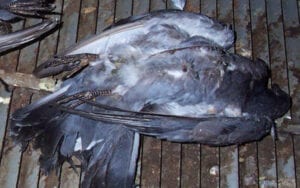
Source
Pigeon Patrol Products & Services is the leading manufacturer and distributor of bird deterrent (control) products in Canada. Pigeon Patrol products have solved pest bird problems in industrial, commercial, and residential settings since 2000, by using safe and humane bird deterrents with only bird and animal friendly solutions. At Pigeon Patrol, we manufacture and offer a variety of bird deterrents, ranging from Ultra-flex Bird Spikes with UV protection, Bird Netting, 4-S Bird Gel and the best Ultrasonic and audible sound devices on the market today.
Voted Best Canadian wholesaler for Bird Deterrent products ten years in a row.
Contact us at 1- 877– 4– NO-BIRD, (604) 585-9279 or visit our website at www.pigeonpatrol.ca
Pigeon/Pigeon Patrol / Pigeons Roosting / Vancouver Pigeon Control /Bird Spikes / Bird Control / Bird Deterrent / Pigeon Deterrent? Surrey Pigeon Control / Pest /Seagull deterrent / Vancouver Pigeon Blog / Birds Inside Home / Pigeons in the cities / Ice Pigeons/ What to do about pigeons/ sparrows , Damage by Sparrows, How To Keep Raccoons Away, Why Are Raccoons Considered Pests/ De-fence / Pigeon Nesting/ Bird Droppings / Pigeon Dropping/ woodpecker control/ Professional Bird Control Company/ Keep The Birds Away/ Birds/rats/ seagull/pigeon/woodpecker/ dove/sparrow/pidgeon control/pidgeon problem/ pidgeon control/flying rats/ pigeon Problems/ bird netting/bird gel/bird spray/bird nails/ bird guard
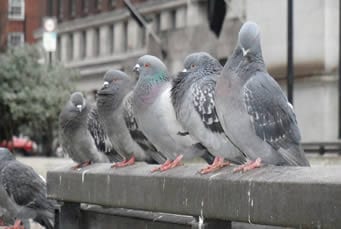
by Pigeon Patrol | Jan 25, 2022 | Bird Deterrent Products, Bird Spikes, Columbidae, Doves, history of pigeons, MBCA, pet bird
Pigeons home along idiosyncratic habitual routes from familiar locations. It has been suggested that memorized visual landmarks underpin this route learning. However, the inability to experimentally alter the landscape on large scales has hindered the discovery of the particular features to which birds attend. Here, we present a method for objectively classifying the most informative regions of animal paths. We apply this method to flight trajectories from homing pigeons to identify probable locations of salient visual landmarks. We construct and apply a Gaussian process model of flight trajectory generation for pigeons trained to home from specific release sites. The model shows increasing predictive power as the birds become familiar with the sites, mirroring the animal’s learning process. We subsequently find that the most informative elements of the flight trajectories coincide with landscape features that have previously been suggested as important components of the homing task.
Source
Pigeon Patrol Products & Services is the leading manufacturer and distributor of bird deterrent (control) products in Canada. Pigeon Patrol products have solved pest bird problems in industrial, commercial, and residential settings since 2000, by using safe and humane bird deterrents with only bird and animal friendly solutions. At Pigeon Patrol, we manufacture and offer a variety of bird deterrents, ranging from Ultra-flex Bird Spikes with UV protection, Bird Netting, 4-S Bird Gel and the best Ultrasonic and audible sound devices on the market today.
Voted Best Canadian wholesaler for Bird Deterrent products ten years in a row.
Contact us at 1- 877– 4– NO-BIRD, (604) 585-9279 or visit our website at www.pigeonpatrol.ca
Pigeon/Pigeon Patrol / Pigeons Roosting / Vancouver Pigeon Control /Bird Spikes / Bird Control / Bird Deterrent / Pigeon Deterrent? Surrey Pigeon Control / Pest /Seagull deterrent / Vancouver Pigeon Blog / Birds Inside Home / Pigeons in the cities / Ice Pigeons/ What to do about pigeons/ sparrows , Damage by Sparrows, How To Keep Raccoons Away, Why Are Raccoons Considered Pests/ De-fence / Pigeon Nesting/ Bird Droppings / Pigeon Dropping/ woodpecker control/ Professional Bird Control Company/ Keep The Birds Away/ Birds/rats/ seagull/pigeon/woodpecker/ dove/sparrow/pidgeon control/pidgeon problem/ pidgeon control/flying rats/ pigeon Problems/ bird netting/bird gel/bird spray/bird nails/ bird guard


by Pigeon Patrol | Jan 25, 2022 | 4-S Gel Bird repellent, Animal Deterrent Products, Bird Deterrent Products, Bird Law, Bird Netting, Bird Spikes
It was the satirist Tom Lehrer who started the rot in 1959 with his song Poisoning Pigeons in the Park, which explained that it takes only a smidgen of strychnine and “it’s not against any religion to want to dispose of a pigeon” (though I doubt that many Buddhists or Jains would agree).
However, Woody Allen delivered the coup de grâce in his 1980 film Stardust Memories, when he referred to feral pigeons as “rats with wings”.
The term had first appeared in 1966 in an article in The New York Times, but Allen’s film reached a much wider audience. It was the final nail in the coffin for these birds – what could be more damning than to be on a par with rats? Ever since, feral pigeons have been one of the Disgusting Three, together with North American grey squirrels (‘tree rats’) and rats themselves. Their fall from grace was dramatic and, amazingly, took just a couple of decades.
Where did feral pigeons come from?
The rock pigeon Columba livia was the wild ancestor of the feral pigeon and the first bird to be domesticated, in the Middle East some 6,000 years ago. Since then its contribution to human wellbeing has been astonishing.
Until agricultural advances in quite recent times, a dovecote, rabbit warren and carp pond were the three essentials to provide fresh meat throughout the year in Europe. In addition to food, pigeons produced valuable guano so rich in nutrients that one load of it was worth 10 from any other species. In many countries, pigeon dung actually played a key part in agricultural development.
It might seem improbable that the rock pigeon, a relatively uncommon species of remote cliffs, was the first bird we domesticated. But this process did not involve capture and selective breeding – merely the provision of an alternative place to nest, usually a dovecote with rows of ledges or clay pots along its internal walls. Some designs could accommodate several thousand sitting females.
The pigeons themselves were given little food, generally flying off to forage elsewhere. Despite requiring minimal attention, each pair typically produced about 10 squabs a year. Pigeons were thus the perfect source of protein.
Darwin loved pigeons
The reliance on pigeons for food declined when it became clear that chickens were more suited to mass production. But the interest in breeding them remained: much of the first chapter of On The Origin of Species is devoted to pigeons, where Darwin describes the many breeds that can be created artificially.
Today, though, the pastimes of rearing and racing pigeons are waning in popularity. Both hobbies require a great deal of patience and dedication – commodities in short supply in the modern world.
Though pigeons were still an important food source in the 1800s, they were being stolen from lofts in large numbers to supply the newly fashionable sport of pigeon shooting: they were used as live targets in competitions.
The Hurlingham Club in London was founded in 1869 expressly for pigeon shooting. When the practice was made illegal in 1921, clay pigeon shooting was invented.
Apart from supplying us with food, fertiliser and fun, pigeons have also played a useful role in medicine. Prolactin, the hormone responsible for milk production in mammals, was first isolated in 1933 in pigeons; the same hormone stimulates the male and female birds to secrete ‘milk’ from their crops to feed their young.
Pigeons in war and peace
But pigeons are probably most famous for their ability to find their way home and deliver messages. This was first exploited 3,000 years ago, and by the fifth century BC Syria and Persia had widespread networks of message-carrying pigeons.
In 1850, Paul Julius Reuter’s fledgling news service used homing pigeons to fly the 120km between Aachen and Brussels, thereby laying the foundations for a global news agency, and the world’s first ‘airmail’ stamps were issued for the Great Barrier Pigeon-Gram Service.
The birds’ homing ability was harnessed in the two world wars: in the early 1940s, the American Signal Pigeon Corps consisted of 3,150 soldiers and 54,000 birds. Some 90 per cent of the messages got through. And these avian secret agents saved countless lives, too – of 54 Dickin Medals (the animal’s VC) awarded in World War II, 32 went to pigeons.
Feral pigeon in front of Lincoln Cathedral. © Oksana Kachkan/Getty
Are messenger pigeons still used anywhere?
Even now, homing pigeons remain a useful means of communication in remote areas. The Police Pigeon Service in Orissa, India, was retired only in 2002.
We are all beguiled by the internet, yet in 2009, as part of a PR stunt, a pigeon carried a 4GB memory stick 80km in South Africa; the country’s biggest internet service provider managed to transfer just 4 per cent of the data on the stick in the same time. Perhaps it’s hardly surprising that the Taliban banned people from keeping or using homing pigeons in Afghanistan.
Amazingly, despite decades of research, we are still not sure how pigeons find their way home over terrain they have never seen before, and with such apparent ease. Partly this confusion is because different breeds appear to rely on different cues.
The consensus is that pigeons use the sun and/or the Earth’s magnetic field on long journeys, with visual cues becoming important near their loft, though recent studies suggest that they may also use odours. Not bad for birds with very small brains.
Urban pigeon outcasts
The list goes on and on: the feral pigeon has contributed to civilisation in more ways than any other species of bird. So how – and, perhaps more importantly, why – has it become such a pariah?
The fundamental reason is that modern technology has rapidly reduced our reliance on pigeons. All that most people see today are the flocks of feral birds found in cities on every continent except Antarctica, the most obvious surviving trace of the close association between people and pigeons spanning several millennia.
It’s no wonder that feral pigeons thrive in urban areas. Buildings are perfect nest sites for these exiles, mimicking the windswept cliffs used by their ancestors. There can be few more stirring sights than masses of pigeons swooping above our city streets, occasionally with peregrines in hot pursuit.
Pigeons as tourist attractions
So it is difficult to see why feral pigeons are now so widely reviled. After all, they’re among the few birds that the average city-dweller sees regularly.
Lots of people enjoy their interactions with these charming birds, which have long drawn the crowds in tourist hotspots such as London’s Trafalgar Square and Venice’s Piazza San Marco.
And let’s not forget that feral pigeons are some of the most beautiful birds you could hope to see. Their plumage has a multitude of different colours, including metallic greens, bronzes and purples on the neck, as well as exquisite wing patterns.
Interestingly, most feral animals quickly revert to the appearance of their wild ancestors. All British mink, for instance, are now the same shade of brown as their wild relatives in North America, even though the original escapees from fur farms had a plethora of coat colours bred for the fur trade.
We don’t know why pigeons are the only feral animals to have retained the varied coloration of their domesticated ancestors.
Are feral pigeons a pest and a nuisance?
It is often said that feral pigeons are a real nuisance, but what exactly are the problems? The standard gripe is that there are too many of them and therefore they need to be controlled. It’s a familiar refrain. The accusation is also levelled at rats, magpies, crows, squirrels, foxes, badgers and deer, to name but a few so-called ‘pests’.
Of course, no one ever says what the ideal number of feral pigeons is, just that there are too many. However, there have been a handful of detailed population estimates, including one in Sheffield: 12,130 feral pigeons in a city of half a million people. This is likely to be typical of our cities.
The BTO’s Garden BirdWatch survey listed the feral pigeon as the 25th most frequently recorded species in the first quarter of 2010, whereas the wood pigeon was number five and the collared dove number eight.
Feral pigeons are also said to be ‘dirty’ because they foul streets and buildings. Personally, I find pigeon droppings much less offensive than graffiti, the chewing gum stuck on pavements and bus seats, and the masses of litter everywhere.
Picking up all of the filth left by people costs vastly more than removing pigeon poo. Likewise, protecting buildings from pigeons costs considerably less than cleaning up after domestic dogs.
Do pigeons carry disease?
Many websites list the diseases recorded in feral pigeons. How very scary. But let’s put this in context – many more diseases are known in people and their pets. Moreover, all animals carry diseases: the key issue is how often they transfer to humans, and there is little evidence of this happening with feral pigeons.
Plus, domestic pigeons often come into contact with feral pigeons but stay perfectly healthy. In other words, feral pigeons simply do not pose a significant health risk. It’s a non-issue.
In November 1855, Charles Darwin, arguably the most famous pigeon fancier of them all, sent a letter to his great friend the geologist Charles Lyell, who was about to pay him a visit. Darwin wrote: “I will show you my pigeons! Which are the greatest treat, in my opinion, that can be offered to a human being.”
How right he was!
FERAL PIGEON TERMINOLOGY: Wild, domestic or feral?
Feral pigeons live worldwide, but their wild ancestors are rare and in retreat. It’s important to get your terminology right when discussing pigeons.
Feral pigeons (sometimes called city, town or street pigeons) are descended from birds that escaped from dovecotes or other captive situations. In turn, domesticated pigeons were bred from wild rock pigeons (a species formerly known as the rock dove, but renamed in 2004).
Feral pigeons live in urban areas on every continent except Antarctica, with a global population numbering in the millions. By contrast, wild rock pigeons are now confined to outlying Scottish islands and remote parts of the Mediterranean, North Africa and western Asia.
But since it is hard to tell feral from wholly wild birds, and hybridisation is rife, it is difficult to map their respective populations accurately.
A day in the life of a city pigeon
The daily routine of a pair of pigeons in central London might look like this…
02.00 The pigeons are roosting side by side on their windowsill nest near Trafalgar Square. Their two eggs hatched a day ago.
06.00 At dawn, the female flies to the square to find food. Meanwhile, her mate gives their chicks some of his rich crop milk.
09.00 The female joins a feeding frenzy as seed is scattered (illegally) by a pigeon lover, before a warden moves the birds on.
11.00 Back at the nest, the female greets her partner with a cooing and bill-rubbing display. He then heads to St James’s Park to be fed by office workers having lunch.
15.00 After preening one another, the pair mate briefly at the nest. The female leaves again, while the male broods the squabs.
20.00 Reunited on their window ledge, the adult pigeons coo and bill-rub together before settling down for the night.
DID YOU KNOW?
- Pigeon ‘milk’ is a cottage cheese-like fluid secreted from the lining of the crop. Flamingos are the only other birds to feed their young this way.
- Experiments have shown that the humble feral pigeon can be trained to distinguish music by Bach and Stravinsky, and paintings by Monet and Picasso.
Source
Pigeon Patrol Products & Services is the leading manufacturer and distributor of bird deterrent (control) products in Canada. Pigeon Patrol products have solved pest bird problems in industrial, commercial, and residential settings since 2000, by using safe and humane bird deterrents with only bird and animal friendly solutions. At Pigeon Patrol, we manufacture and offer a variety of bird deterrents, ranging from Ultra-flex Bird Spikes with UV protection, Bird Netting, 4-S Bird Gel and the best Ultrasonic and audible sound devices on the market today.
Voted Best Canadian wholesaler for Bird Deterrent products ten years in a row.
Contact us at 1- 877– 4– NO-BIRD, (604) 585-9279 or visit our website at www.pigeonpatrol.ca
Pigeon/Pigeon Patrol / Pigeons Roosting / Vancouver Pigeon Control /Bird Spikes / Bird Control / Bird Deterrent / Pigeon Deterrent? Surrey Pigeon Control / Pest /Seagull deterrent / Vancouver Pigeon Blog / Birds Inside Home / Pigeons in the cities / Ice Pigeons/ What to do about pigeons/ sparrows , Damage by Sparrows, How To Keep Raccoons Away, Why Are Raccoons Considered Pests/ De-fence / Pigeon Nesting/ Bird Droppings / Pigeon Dropping/ woodpecker control/ Professional Bird Control Company/ Keep The Birds Away/ Birds/rats/ seagull/pigeon/woodpecker/ dove/sparrow/pidgeon control/pidgeon problem/ pidgeon control/flying rats/ pigeon Problems/ bird netting/bird gel/bird spray/bird nails/ bird guard
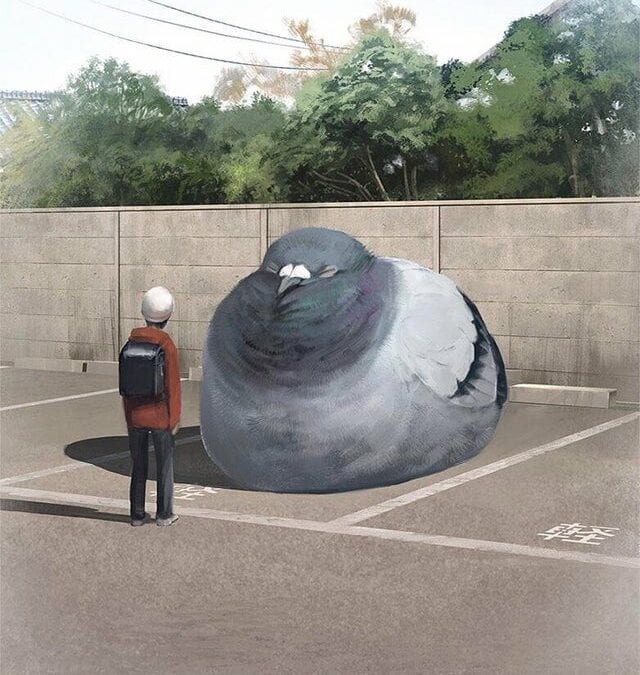
by Pigeon Patrol | Jan 25, 2022 | Columbidae, Doves, history of pigeons, MBCA, pet bird
Turning is crucial for animals, particularly during predator–prey interactions and to avoid obstacles. For flying animals, turning consists of changes in (i) flight trajectory, or path of travel, and (ii) body orientation, or 3D angular position. Changes in flight trajectory can only be achieved by modulating aerodynamic forces relative to gravity. How birds coordinate aerodynamic force production relative to changes in body orientation during turns is key to understanding the control strategies used in avian maneuvering flight. We hypothesized that pigeons produce aerodynamic forces in a uniform direction relative to their bodies, requiring changes in body orientation to redirect those forces to turn. Using detailed 3D kinematics and body mass distributions, we examined net aerodynamic forces and body orientations in slowly flying pigeons (Columba livia) executing level 90° turns. The net aerodynamic force averaged over the downstroke was maintained in a fixed direction relative to the body throughout the turn, even though the body orientation of the birds varied substantially. Early in the turn, changes in body orientation primarily redirected the downstroke aerodynamic force, affecting the bird’s flight trajectory. Subsequently, the pigeon mainly reacquired the body orientation used in forward flight without affecting its flight trajectory. Surprisingly, the pigeon’s upstroke generated aerodynamic forces that were approximately 50% of those generated during the downstroke, nearly matching the relative upstroke forces produced by hummingbirds. Thus, pigeons achieve low speed turns much like helicopters, by using whole-body rotations to alter the direction of aerodynamic force production to change their flight trajectory.
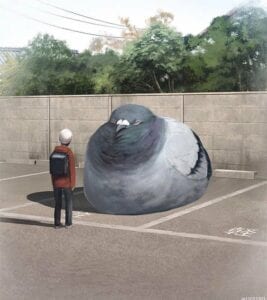
Source
Pigeon Patrol Products & Services is the leading manufacturer and distributor of bird deterrent (control) products in Canada. Pigeon Patrol products have solved pest bird problems in industrial, commercial, and residential settings since 2000, by using safe and humane bird deterrents with only bird and animal friendly solutions. At Pigeon Patrol, we manufacture and offer a variety of bird deterrents, ranging from Ultra-flex Bird Spikes with UV protection, Bird Netting, 4-S Bird Gel and the best Ultrasonic and audible sound devices on the market today.
Voted Best Canadian wholesaler for Bird Deterrent products ten years in a row.
Contact us at 1- 877– 4– NO-BIRD, (604) 585-9279 or visit our website at www.pigeonpatrol.ca
Pigeon/Pigeon Patrol / Pigeons Roosting / Vancouver Pigeon Control /Bird Spikes / Bird Control / Bird Deterrent / Pigeon Deterrent? Surrey Pigeon Control / Pest /Seagull deterrent / Vancouver Pigeon Blog / Birds Inside Home / Pigeons in the cities / Ice Pigeons/ What to do about pigeons/ sparrows , Damage by Sparrows, How To Keep Raccoons Away, Why Are Raccoons Considered Pests/ De-fence / Pigeon Nesting/ Bird Droppings / Pigeon Dropping/ woodpecker control/ Professional Bird Control Company/ Keep The Birds Away/ Birds/rats/ seagull/pigeon/woodpecker/ dove/sparrow/pidgeon control/pidgeon problem/ pidgeon control/flying rats/ pigeon Problems/ bird netting/bird gel/bird spray/bird nails/ bird guard
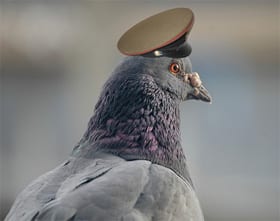
by Pigeon Patrol | Jan 25, 2022 | Bird Spike, Pigeon Spikes, Pigeons, Pigeons in the News, Raccoons, Sparrows, UltraSonic Bird Control
A freewheeling flock of birds is one of nature’s most endearing spectacles. The flock’s members move with uncanny coordination, changing direction in unison, splitting and reforming, and even landing as one. The intricacies of these synchronised flights are very difficult to entangle. Who is following whom? Is there even a leader and, if so, does the same bird always take up pole position? Our feeble eyes could never hope to discern the answers just by watching a flying flock. But fortunately, we have technology that can do the job for us.
, Budapest, has found that flying pigeons obey strict chains of command, even when in flight. He used state-of-the-art GPS devices to track the movements of groups of ten pigeons with exquisite sensitivity. The lightweight monitors, just 16g in weight, captured the subtleties of the pigeons’ twists and turns in mere fractions of a second. Back on the ground, Nagy analysed their recordings to show that pigeons fly according to the pecking orders they establish on the ground. The dominant bird takes the lead and the others follow his directions. Studying the collective movements of animal groups has been a difficult challenge. Many cameras can be used to film animals moving within the same block of space, but the jostling bodies often block one another from view. Mathematical models can tell us about the basic rules that groups of moving animals adhere to, but they are difficult to test in real life. But our technology has now become advanced enough to start skirting around these problems. For scientists studying birds, the key breakthrough was the creation of sensors that are light enough to be strapped to a flying bird without compromising its aerial abilities. Now, these sensors include GPS devices that can record a bird’s speed and direction every fifth of a second. Nagy attached such devices to 13 homing pigeons and watched as they flew in flocks of 7 to 11 birds.

Nagy catalogued every instance when one pigeon changed direction only to be followed by another. By pooling together this data, he created a network of leaders and followers, showing the relationship of each bird to its peers. This colourful diagram shows one such network. Each circle represents an individual pigeon, the arrows point from a leading bird to one that follows it, and the numbers represent the time delay between the leader’s movements and those of its follower’s. The networks showed that flocking pigeons maintain a dependable hierarchy on the wing. On average, when a leading bird changed direction, its followers would follow suit after around a third of a second. Birds will consistently copy the movements of specific individuals further up the pecking order and, in turn, they are consistently copied by more junior underlings. What makes a leading pigeon? It seems that skill counts for something. Nagy released each of his birds on a solo flight, some distance from home. When they returned, he found that those who arrived home quickest were also most likely to wield leadership authority, although this link between navigation ability and seniority wasn’t quite statistically significant. Indeed, the chains of seniority within pigeon flocks are fairly flexible, changing dynamically from flight to flight. Influential birds tend to remain influential but Tamas Vicsek, who led the study, says, “There are days when the pigeon which takes the role most of the time is less active. Perhaps it did not have a good sleep! During these days some of the birds on lower levels of the hierarchy have their chance to lead.” Nagy’s data also revealed that leaders do indeed take up pole position at the front of the flock. That may seem intuitively obvious to us, but remember that pigeons have a field of vision that extends for almost a full 360 degrees. When you can easily see individuals flying behind you, the leading bird doesn’t necessarily need to be at the front, and yet it does. More surprisingly, leaders also tend to stay on the left of the flock. Nagy found that the more time that a bird spent behind a leading partner, the more likely it was to be flying on that partner’s right. There’s an obvious reason for this – like us, pigeons have highly asymmetric brains with each half wielding greater influence over certain thought processes. Their right brain, which receives signals from the left eye, controls the ability to recognise other pigeons. So if a pigeon sees one of its peers through its left eye, rather than its right, it responds more quickly or more strongly.
Source
Pigeon Patrol Products & Services is the leading manufacturer and distributor of bird deterrent (control) products in Canada. Pigeon Patrol products have solved pest bird problems in industrial, commercial, and residential settings since 2000, by using safe and humane bird deterrents with only bird and animal friendly solutions. At Pigeon Patrol, we manufacture and offer a variety of bird deterrents, ranging from Ultra-flex Bird Spikes with UV protection, Bird Netting, 4-S Bird Gel and the best Ultrasonic and audible sound devices on the market today.
Voted Best Canadian wholesaler for Bird Deterrent products ten years in a row.
Contact us at 1- 877– 4– NO-BIRD, (604) 585-9279 or visit our website at www.pigeonpatrol.ca
Pigeon/Pigeon Patrol / Pigeons Roosting / Vancouver Pigeon Control /Bird Spikes / Bird Control / Bird Deterrent / Pigeon Deterrent? Surrey Pigeon Control / Pest /Seagull deterrent / Vancouver Pigeon Blog / Birds Inside Home / Pigeons in the cities / Ice Pigeons/ What to do about pigeons/ sparrows , Damage by Sparrows, How To Keep Raccoons Away, Why Are Raccoons Considered Pests/ De-fence / Pigeon Nesting/ Bird Droppings / Pigeon Dropping/ woodpecker control/ Professional Bird Control Company/ Keep The Birds Away/ Birds/rats/ seagull/pigeon/woodpecker/ dove/sparrow/pidgeon control/pidgeon problem/ pidgeon control/flying rats/ pigeon Problems/ bird netting/bird gel/bird spray/bird nails/ bird guard

by Pigeon Patrol | Jan 25, 2022 | Pigeon Droppings, Pigeon Patrol's Services, Pigeon Predators, Pigeon Spikes, Pigeons, Pigeons in the News
Even the bird-brained can follow a leader. When pigeons fly in flocks, each bird falls behind another with better navigational skill, and the savviest among them leads the flock, scientists report in the April 8 Nature.
The research suggests hierarchies can serve peaceful purposes in the animal kingdom, where dominance by brute force is often the rule. “A pecking order tends to be just that — a pecking order,” says Iain Couzin of Princeton University, an expert in collective behavior who was not involved in the research.
The research also suggests that for pigeons, dominance isn’t set in stone. While one bird often emerged as the leader, other birds also stepped up. This flexibility in leadership had previously been seen only in some small groups of fish.
From schools to packs to swarms to flocks, collective behavior is widespread among animals. But in many cases, the important interactions are with nearest neighbors, and control of the group’s movement is distributed among members rather than hierarchical.

Biological physicist Tamás Vicsek of Eötvös Loránd University in Budapest and his colleagues studied flight dynamics in homing pigeons, which fly in flocks but conveniently return to their roosts. The researchers outfitted 13 pigeons with tiny backpacks carrying GPS devices that measured shifts in birds’ flight direction five times per second. Flocks of eight to 10 birds flew with the devices during homing flights (a roughly 14-kilometer trip back to the roost) and spontaneous “free” flights near home. Each bird also flew solo flights of about 15 kilometers each.
Analysis of GPS logs showed that for each excursion, the flock had one leader followed by at least three or four other birds. Each of these followers was in turn followed by other birds in the flock. Comparing the solo flight paths to the group flights showed that the birds with the best navigational skills led the flock.
While flocks have hierarchies, they’re not dictatorships, notes Vicsek. One bird led eight of the 13 flights, while other birds took the lead on the rest of the trips. Vicsek likens the dynamics to a group of peers deciding where to eat dinner. “Maybe someone knows the area restaurants best, or there is a person who’s a gourmand — or maybe they are the most outspoken,” he says. This one person might pick the place to eat for several nights, although another person might chime in now and then. And then there is the person with no say, whom everyone knows has terrible taste in food.
“These pigeons know each other. They know which is the smartest. The fastest bird will even follow the slower one who knows the way home the best,” say Vicsek. Videos of the birds’ positions during flight showed that if the best navigator moves a little to the left, it takes about a third of a second for other birds to do the same. But if the least savvy bird makes a move “the others don’t care,” Vicsek says.
Pigeons’ brains may be wired for follow-the-leader, comments behavioral neuroscientist Lucia Jacobs of the University of California, Berkeley. When the left eye sees something, for example, it sends all the visual information to the right brain hemisphere, and vice versa. This “extreme lateralization” may play a role in organizing flocks, the new work suggests. A pigeon following another was most likely to be flying on its partner’s right, seeing this leader with its left eye. “It’s very cool,” Jacobs says.
Source
Pigeon Patrol Products & Services is the leading manufacturer and distributor of bird deterrent (control) products in Canada. Pigeon Patrol products have solved pest bird problems in industrial, commercial, and residential settings since 2000, by using safe and humane bird deterrents with only bird and animal friendly solutions. At Pigeon Patrol, we manufacture and offer a variety of bird deterrents, ranging from Ultra-flex Bird Spikes with UV protection, Bird Netting, 4-S Bird Gel and the best Ultrasonic and audible sound devices on the market today.
Voted Best Canadian wholesaler for Bird Deterrent products ten years in a row.
Contact us at 1- 877– 4– NO-BIRD, (604) 585-9279 or visit our website at www.pigeonpatrol.ca
Pigeon/Pigeon Patrol / Pigeons Roosting / Vancouver Pigeon Control /Bird Spikes / Bird Control / Bird Deterrent / Pigeon Deterrent? Surrey Pigeon Control / Pest /Seagull deterrent / Vancouver Pigeon Blog / Birds Inside Home / Pigeons in the cities / Ice Pigeons/ What to do about pigeons/ sparrows , Damage by Sparrows, How To Keep Raccoons Away, Why Are Raccoons Considered Pests/ De-fence / Pigeon Nesting/ Bird Droppings / Pigeon Dropping/ woodpecker control/ Professional Bird Control Company/ Keep The Birds Away/ Birds/rats/ seagull/pigeon/woodpecker/ dove/sparrow/pidgeon control/pidgeon problem/ pidgeon control/flying rats/ pigeon Problems/ bird netting/bird gel/bird spray/bird nails/ bird guard
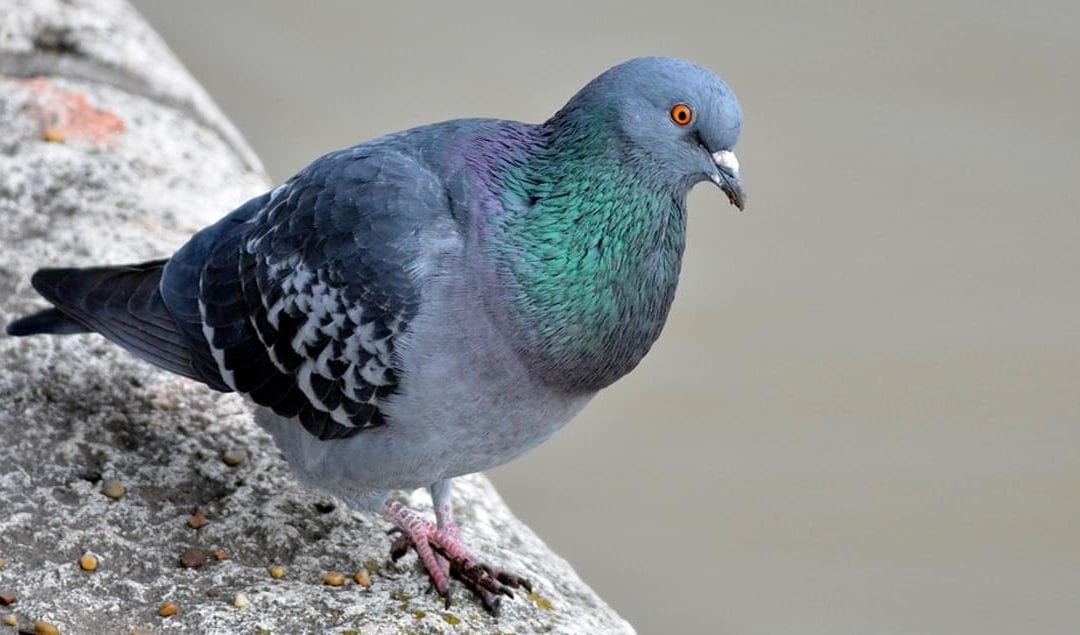
by Pigeon Patrol | Jan 4, 2022 | Pigeon Predators, Pigeon Spikes, Pigeons, Pigeons in the News, Raccoons, Sparrows
Pigeons are those cute, plump little birds that seem to pop up everywhere. From the Rock Pigeon to the Mourning Dove, there are many different types of these birds roaming in the city and country. One unique habit of these birds is the way they nest. They have a unique way of building their nests, taking turns sitting on the eggs, and then taking care of their young in that nest. We have all you need to know about pigeon nesting habits.
Pigeon Nest Locations
The main requirement for a pigeon nesting site is that it is dry and protected on a flat surface. They usually like to nest in attics, on roofs, ledges, eaves, and under bridges. Their natural nesting site would be on a rocky cliff crevice or in a cave. This is why they typically nest on high, flat ledges.
Courting And The Nest
The nest isn’t a true home until a male pigeon finds his mate. The male starts to build the nest while calling out for a mate. He’ll sit on the nesting site until he attracts his lady. He will often strut around cooing at his favorite lady. If the female is interested, she will return the favor. The two will “kiss” by billing each other. After the male pigeon attracts his favorite female pigeon, he will start searching for nesting material. He does not want to waste any time. He will start to bring her one twig at a time. If the female pigeon doesn’t stay up to his pace, he will drive her into the nest and strike her with his wings. Finally, the female will take the twigs he has brought her, tucking them underneath her as the nest starts to build around her. Pigeons usually remain together for eternity. They usually mate in pairs. After they go through their dating stage and mate, it’s time to have squabs. If one of the pigeons passes away or is somehow separated, one will mate with another single bird. During the day, the male sits on the completed nest that usually contains one or two eggs. The female will take her turn overnight. Pigeons nest throughout the year. They might have 10 squabs each year.
The Look Of A Pigeon Nest
If you stumble upon a pigeon’s nest, it’s not a pretty sight. It looks like a mess of grass stems, pine needles, twigs, sticks, and other debris. It’s piled up with a small depression in the middle. A nest is used throughout the year, so it will start to accumulate more droppings and feathers. Many birds remove droppings from the nest, but pigeons do not. The droppings start to essentially glue together all of the nesting materials. After a brood is pushed out of the nest, the pair uses the same site for the next brood. They simply add new nesting material. These “new” nests may include mummies of pigeons that didn’t survive and unhatched eggs. A nest that is reused multiple years may grow up to eight inches tall and 20 inches wide. They may weigh almost five pounds.
Nest Eggs
The female usually lays about two eggs within the first few days of nesting. One unique thing about pigeons is that both the male and female will sit on the eggs to insulate them. Most of the time, the female will be in the nest from the middle of the afternoon to the middle of the morning. This will go on for about 18 days.
The young pigeons called “squabs” are born covered in yellow down. While the squabs are in the nest, they eat crop milk. Crop milk is thick regurgitated liquid that comes straight from the parents’ mouth. Squabs are fed this way for about ten days when they can start eating what the adult female and male pigeon eat. The squabs will double their size in about two days. This makes baby pigeons one of the fastest growing vertebrates. In two weeks, baby pigeons will get their flight feathers. They’re covered in feathers by their third week of life. Their tail will completely full of feathers by their 28th day of life. It’s now time to leave the nest. The time that a squab is in their nest is about 15 days longer than most backyard birds. Once the pigeon is gone, the female pigeon will begin laying new eggs almost every month.
Getting A Glimpse Of Squabs
Many people wonder why they never see baby pigeons. This is because baby pigeons love their nest. They hang out in their nest as their feathers grow in. Squabs are a tasty dinner, so it’s important they stay in their nest so they aren’t eaten. The baby pigeons will finally leave their nest when they are full grown. The short, fat pigeons that are usually seen on your lawn, woodpigeons, you’ll be able to identify a young pigeon because they don’t have a white flash on their neck until they’re adults. Getting a glimpse of these babies is tough because they’re well protected and don’t need to leave until it’s time.
Unique Eating In The Nest
If you are lucky enough to observe baby pigeons, you’ll notice their feeding cycle is unique to other birds. Besides eating their crop milk, they have other special patterns. Either the female or the male will feed the squabs. Once the parent lands near their nest, it seems to be a race as to which bird will be the first to insert their tiny beak to get that food. The parents stay dedicated to feeding their babies until they’re able to leave the nest. Every day, one or the other would arrive with food for the young birds.
NOTE: though tempting, if you stumble upon a pigeon nest, try to resist the urge to feed the squabs yourself. It’s important that they get fed by mom or dad. If you want to help out and do your part, the adult pigeons would probably love some pigeon seed.
Returning Home
Pigeons are loyal to their nests. As we mentioned before, they have numerous broods in one nest. These birds are known to return to whatever their home may be. Pigeons were used to carry messages are far back as 2500 BC, The ancient Greeks and Romans used them to carry messages, then Persia and Syria made a messaging service with pigeons. In the 19th century, pigeons carried messages for news agencies and financial institutions and news agencies in Europe and even providing an airmail service in New Zealand. The point is that pigeons are a bird that know how to take a message somewhere then return home. They can gather food all day, then return to their nest without any issues.
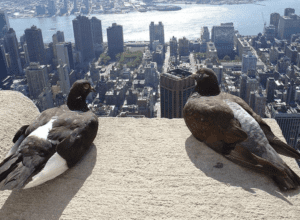
Pigeon Nests And You
Depending on where you live, you may want to help provide nests for the local pigeons (or alternatively if there are too many pigeons around already, possibly deter them from nesting in your area). Here are some tips:
Providing Nests
If you are in a place where you can provide a nest for pigeons, it’s important that each pair of birds gets at least two nests. This is because pigeons usually have a few broods of squads. They need two nests so they can adequately care for each brood of the baby pigeons or their eggs. Their nest should be build twelve inches square. You should always attach a three-inch long perch. They prefer tobacco stems, straw, or hay as the base of a constructed nest.
Deterring Nests
If you would rather your home not become a nest for these sweet squabs, you should keep things very clean. Pigeons like to build nests in a place of shelter. They don’t like a lot clutter or clamor. They usually make their nests when no one is using an areas. If you don’t want them on your patio, make sure to keep it swept. They love to pick up leftover debris to make nests.
Moving A Nest
It’s important to never move a pigeon’s nest. It might seem normal if you think they might be in danger, but a nest location is critical to their survival. Only licensed professionals can move a pigeon’s nest. Pigeons don’t have a sense of smell to find their new nesting location. If you move a nest, the parent may abandon their young. This is critical because squabs need parents, even after they have left the nest. The male and female pigeon will still show their young how to escape from predators, fly, and integrate with the flock. If you need to move a nest, it is best to wait a few months until the squabs are for sure out and about on their own. The parents will be forced to make a new nest elsewhere for their next brood.
Backyard Tips
You may spot a pigeon in your backyard. They are attracted to large, open areas where it is easy for them to find food places on the ground. The only issue with this is that ground food can attract rodents. It’s usually best to only feed pigeons when you see them in your yard. They enjoy peas, dried corn, or sorghum.
Final Words
A pigeon nest is a unique home that can house hundreds of birds over time. Each brood is full of new squabs hungry for their new life. If you get a chance to see a squab in their pigeon nest, take note of the excitement. The nest is an artistic place where parents can raise dozens of little squabs until they’re ready to bust into the world on their own.
Pigeon Patrol Products & Services is the leading manufacturer and distributor of bird deterrent (control) products in Canada. Pigeon Patrol products have solved pest bird problems in industrial, commercial, and residential settings since 2000, by using safe and humane bird deterrents with only bird and animal friendly solutions. At Pigeon Patrol, we manufacture and offer a variety of bird deterrents, ranging from Ultra-flex Bird Spikes with UV protection, Bird Netting, 4-S Bird Gel and the best Ultrasonic and audible sound devices on the market today.
Voted Best Canadian wholesaler for Bird Deterrent products ten years in a row.
Contact us at 1- 877– 4– NO-BIRD, (604) 585-9279 or visit our website at www.pigeonpatrol.ca
Pigeon/Pigeon Patrol / Pigeons Roosting / Vancouver Pigeon Control /Bird Spikes / Bird Control / Bird Deterrent / Pigeon Deterrent? Surrey Pigeon Control / Pest /Seagull deterrent / Vancouver Pigeon Blog / Birds Inside Home / Pigeons in the cities / Ice Pigeons/ What to do about pigeons/ sparrows , Damage by Sparrows, How To Keep Raccoons Away, Why Are Raccoons Considered Pests/ De-fence / Pigeon Nesting/ Bird Droppings / Pigeon Dropping/ woodpecker control/ Professional Bird Control Company/ Keep The Birds Away/ Birds/rats/ seagull/pigeon/woodpecker/ dove/sparrow/pidgeon control/pidgeon problem/ pidgeon control/flying rats/ pigeon Problems/ bird netting/bird gel/bird spray/bird nails/ bird guard

by Pigeon Patrol | Jan 4, 2022 | Columbidae, Doves, history of pigeons, MBCA, pet bird, Pigeon Control
Spotting a bird’s nest can fill families with delight – but what about when the inhabitants of a nest on your property are notorious pest birds?
More specifically: should you be worried about nesting pigeons on your property?
Pigeons have a reputation – and not entirely unfairly – as flying rats. As this is down to their propensity to spread disease, which, in itself, justifies any concerns you may have over finding a pigeon nest in your garden.

Can I move a pigeon nest?
Like all wild birds, nesting pigeons are protected by the law and can only be moved in exceptional circumstances.
It is considered an offence to move a nest during nesting season, which usually runs from spring through the summer.
These same rules apply to pigeons, so if you have serious concerns it is essential to seek professional advice.
Any attempt to move a bird’s nest should only be made when you are sure that the fledglings have left and it is dormant.
With pigeons, however, this can be trickier as they can often lay eggs three times throughout the summer and do not as a rule nest and lay eggs seasonally. This means that a nest could theoretically be in use year-round.
Why should I be worried about nesting pigeons?
The main concern people usually have relating to pigeons is the spread of disease. They have been linked to the spread of diseases such as histoplasmosis, which can cause serious lung problems, and salmonella.
This is spread through contact with pigeon droppings – or breathing in airborne particles.
Obviously when a pigeon is nesting close to the living area of your home, or in an area used for preparing or eating food this is more of a risk.
Likewise, many homeowners will be unhappy to discover pigeons nesting in their roof due to concerns about the spread of disease.
However, this is less of a problem if a pigeon’s nest has been found in your garden.
Along with the risk of disease, pigeons’ pest bird status owes something to the noise and mess these birds bring with them. Pigeon droppings can cause a hazard on walkways, encourage weeds and moss to grow on roofs and look unsightly. They are also noisy birds, which, in numbers can cause a noise nuisance around your home.
What should I do if pigeons are nesting on my property?
If a nest is established in an area where there are no serious safety concerns you will need to allow the eggs to hatch and fledgling birds to leave before you take action.
It is always advisable to seek help from a pest bird control expert, such as Total Bird Control to ensure that you act within the law. The best way to prevent pigeons returning to the property is to put in place pigeon deterrents, such as spikes and netting
Source
Pigeon Patrol Products & Services is the leading manufacturer and distributor of bird deterrent (control) products in Canada. Pigeon Patrol products have solved pest bird problems in industrial, commercial, and residential settings since 2000, by using safe and humane bird deterrents with only bird and animal friendly solutions. At Pigeon Patrol, we manufacture and offer a variety of bird deterrents, ranging from Ultra-flex Bird Spikes with UV protection, Bird Netting, 4-S Bird Gel and the best Ultrasonic and audible sound devices on the market today.
Voted Best Canadian wholesaler for Bird Deterrent products ten years in a row.
Contact us at 1- 877– 4– NO-BIRD, (604) 585-9279 or visit our website at www.pigeonpatrol.ca
Pigeon/Pigeon Patrol / Pigeons Roosting / Vancouver Pigeon Control /Bird Spikes / Bird Control / Bird Deterrent / Pigeon Deterrent? Surrey Pigeon Control / Pest /Seagull deterrent / Vancouver Pigeon Blog / Birds Inside Home / Pigeons in the cities / Ice Pigeons/ What to do about pigeons/ sparrows , Damage by Sparrows, How To Keep Raccoons Away, Why Are Raccoons Considered Pests/ De-fence / Pigeon Nesting/ Bird Droppings / Pigeon Dropping/ woodpecker control/ Professional Bird Control Company/ Keep The Birds Away/ Birds/rats/ seagull/pigeon/woodpecker/ dove/sparrow/pidgeon control/pidgeon problem/ pidgeon control/flying rats/ pigeon Problems/ bird netting/bird gel/bird spray/bird nails/ bird guard
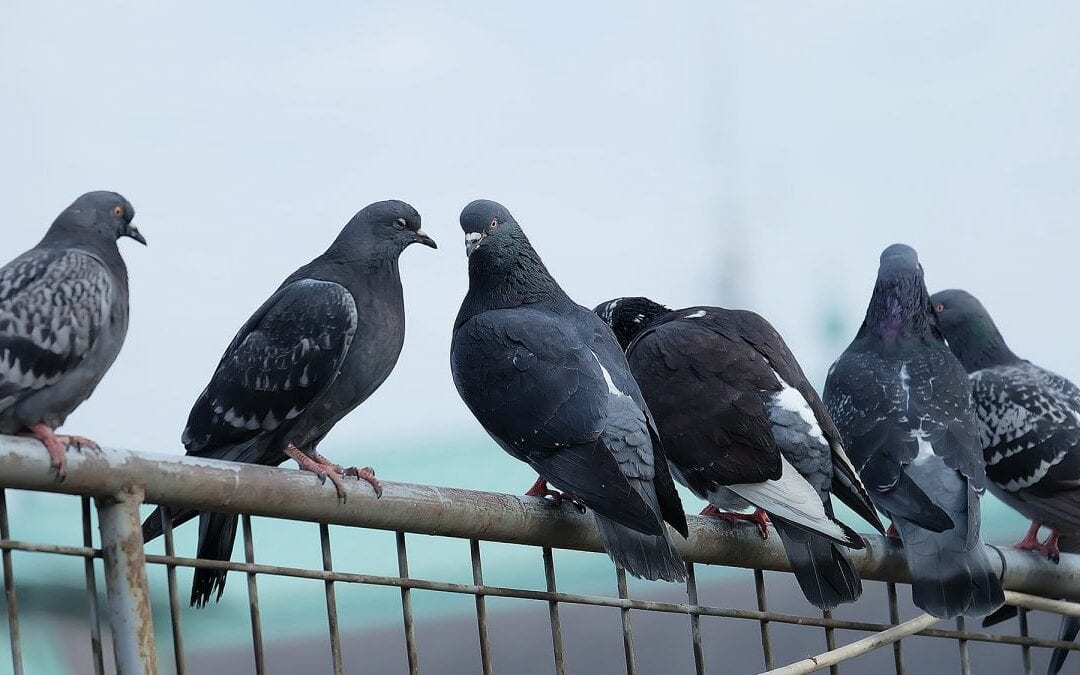
by Pigeon Patrol | Jan 4, 2022 | Bird Deterrent Products, Bird Law, Bird Netting, Bird Spikes, Columbidae
Did you find a pigeon nest with eggs in the geranium pot on the balcony? I bet that’s why you’re reading this article. Maybe you’re wondering what to do with it.
Do you keep it? Can you touch the pigeon eggs? Should you feed the mother bird?… Well, think again.
What should be done if you find a pigeon’s nest on your balcony?
If you find a pigeon’s nest on your balcony, the best thing to do is to get rid of it. Pigeons represent a severe health hazard for you and your loved ones. Do not touch it with your bare hands. Wear a pair of gloves, and remove it from your balcony.
Get rid of the nest together with its eggs. In order to discourage the mother to return to the nest, try placing a toy snake where you found the nest. Hopefully, this will scare the bird for a while.
Am I too cruel? Probably. However, as much as I love animals, in this specific case, I have no doubts: get rid of the nest and the eggs as fast as you can! Let me explain why.
Are pigeons dangerous?
Pigeons, especially those who live in the city, are carriers of diseases that sometimes can be very serious. They are not the kind of animal you want to keep as a pet on your balcony.
Not to mention how messy they are! Yes, you guessed it right. I am talking about their infamous droppings. Worthwhile mentioning it, three primary diseases are associated with pigeons that are dangerous for humans: Histoplasmosis, Cryptococcosis, and Psittacosis. Let’s explore this topic a little bit more.
HISTOPLASMOSIS:
Histoplasmosis is an infection caused by breathing in the spores of a fungus found in bird droppings. This disease affects the lungs. You can catch this disease by inhaling the spores in the air while performing cleaning jobs or any other type of project (such as renovations or demolitions) that can raise high levels of spores in the air, . The majority of people are asymptomatic; however, Histoplasmosis can be dangerous for those with a compromised immune system, such as infants and the elderly. As I said before, the majority of people won’t develop any symptoms, however, when the infection is severe, it can lead to a high fever, chest pains, and fatigue.
Some people can develop a chronic form of Histoplasmosis, which includes a bloody cough, mimicking symptoms of tuberculosis. If untreated, this disease could be fatal.
CRYPTOCOCCOSIS:
Cryptococcosis is caused by a fungus known as Cryptococcosis neoformans. It is a disease that affects the lungs and is associated with pigeon droppings, soil, and unwashed fruit. This disease is contagious and can spread from person to person. Generally, healthy people won’t develop any symptoms, but people with a compromised immune system such as elderly or infants are at a higher risk for contracting the disease. This infection attacks mostly the lungs, with minimal symptoms. In some rare cases, however, it can spread to the brain, the urinary tract, and the bones. When the infection reaches the brain, it can lead to meningitis and other serious complications.
PSITTACOSIS:
Psittacosis is also known as Ornithosis or Parrot Fever. It is an infection caused by a Chlamydia Psittaci, a fungus present in bird droppings. People can catch the disease by inhaling the fungus spores that are in the air. Symptoms can vary from headache, fever, dry cough, and pneumonia. People who are most affected by this disease are pet shop owners, workers in aviaries, and veterinary facilities. Psittacosis cannot be transmitted from person to person.
If the above still hasn’t convinced you, here is a list that will change your mind. You really don’t want to keep these pesty birds anywhere near you. Besides being disgusting, pigeon droppings are corrosive and can cause significant damage to roofs and balconies. It is also really difficult to scrap it from floors, and most probably will leave a stain if not cleaned in time. Also, the droppings are really hard to remove from smooth surfaces such as your car, the patio floor, but also from your clothes and your shoes.
The droppings can attract other unwelcome guests to your premises, such as flies and rats. Pigeons might cause damage to your vegetable garden. These birds are territorial and will scare smaller beneficial birds such as hummingbirds. They tend to return from season to season, which makes it very challenging to chase them away.
Well, now that I have convinced you to dispose of the pigeon’s nest with its eggs, comes the messy part: how to clean the balcony from pigeon droppings.
How to clean pigeon droppings
Generally speaking, cleaning windows and windowsills does not pose a health risk to you or to your family. However, you will need to take some precautions such as:
- Wearing disposable gloves and a mask
- Wearing closed-toe shoes
- Washing your clothes immediately after dealing with the droppings
- If you are thinking of scraping the dropping, wet them beforehand, to prevent inhaling the fungus spores that float in the air.
- Brush with warm soapy water. Where needed, you can add some baking soda to the soapy water solution. Throw away the brush or the sponge-cloth that you used for cleaning.
- Rinse thoroughly with a hose.
As I said before, pigeons will return, and once they spot your balcony as their favorite nesting place, you are doomed. They will return every season and nest there.
How do you tell if a pigeon is going to lay eggs in your balcony?
As soon as spring comes, around March/April, pigeons begin to look for air vents, vases, hidden corners on the terraces to establish their nest and create a family. You will surely notice a continuous flutter forward and backward. It’s the parents which take turns as soon as they establish their nest.
It will be challenging to move them. These birds will remember your house and will want to go back for generations.
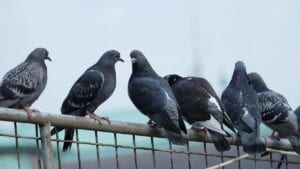
How to get rid of pigeons & How to prevent them from returning to your home
The secret to prevent pigeons from returning to your house is to make their landing place as inconvenient as possible. This is what you can do to scare pigeons off your property and to prevent from nesting in the future:
- Install some anti-roosting spikes. They are by far the most effective pigeon deterrents. I found them on Amazon and are pretty easy to install.
- Install a bird deterrent gel that is commercially available and that works on a multi-sensory level using sight, smell, and touch. This gel makes the surface where the pigeon lands very sticky.
- Install a wind chime on your balcony or your patio.
- Fasten some aluminum foil strings on your balcony railings.
- Put a decoy crow on your roof. Move the crow from time to time as pigeons are very clever and they will get use to it.
- Put a screen over attic vents, chimneys, and anywhere they can create a nest.
- Put a toy snake on your balcony or the place where they might build their nest. Once I made my own decoy DIY snake from a souvenir alligator head from Florida. I filled a black sock with some clothes and slipped it on the alligator’s head. (A word of advice: as time passes, just remember where you placed the snake… it might suddenly scare you to death when you least expect it! I am speaking from experience!)
I hope I have convinced you that pigeons are messy and also carry parasites. You won’t regret getting rid of their nest. Besides, have you ever seen what pigeon chicks look like? They are the scariest chicks ever!!
Source
Pigeon Patrol Products & Services is the leading manufacturer and distributor of bird deterrent (control) products in Canada. Pigeon Patrol products have solved pest bird problems in industrial, commercial, and residential settings since 2000, by using safe and humane bird deterrents with only bird and animal friendly solutions. At Pigeon Patrol, we manufacture and offer a variety of bird deterrents, ranging from Ultra-flex Bird Spikes with UV protection, Bird Netting, 4-S Bird Gel and the best Ultrasonic and audible sound devices on the market today.
Voted Best Canadian wholesaler for Bird Deterrent products ten years in a row.
Contact us at 1- 877– 4– NO-BIRD, (604) 585-9279 or visit our website at www.pigeonpatrol.ca
Pigeon/Pigeon Patrol / Pigeons Roosting / Vancouver Pigeon Control /Bird Spikes / Bird Control / Bird Deterrent / Pigeon Deterrent? Surrey Pigeon Control / Pest /Seagull deterrent / Vancouver Pigeon Blog / Birds Inside Home / Pigeons in the cities / Ice Pigeons/ What to do about pigeons/ sparrows , Damage by Sparrows, How To Keep Raccoons Away, Why Are Raccoons Considered Pests/ De-fence / Pigeon Nesting/ Bird Droppings / Pigeon Dropping/ woodpecker control/ Professional Bird Control Company/ Keep The Birds Away/ Birds/rats/ seagull/pigeon/woodpecker/ dove/sparrow/pidgeon control/pidgeon problem/ pidgeon control/flying rats/ pigeon Problems/ bird netting/bird gel/bird spray/bird nails/ bird guard


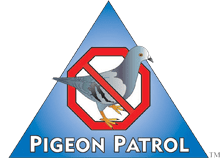




 Thomson Reuters, also known as The Answer Company, is the world’s largest provider of news and information to businesses and professionals. As early as the 1850s, they were sending news of bond prices across the English Channel on carrier pigeons.
Thomson Reuters, also known as The Answer Company, is the world’s largest provider of news and information to businesses and professionals. As early as the 1850s, they were sending news of bond prices across the English Channel on carrier pigeons.




























